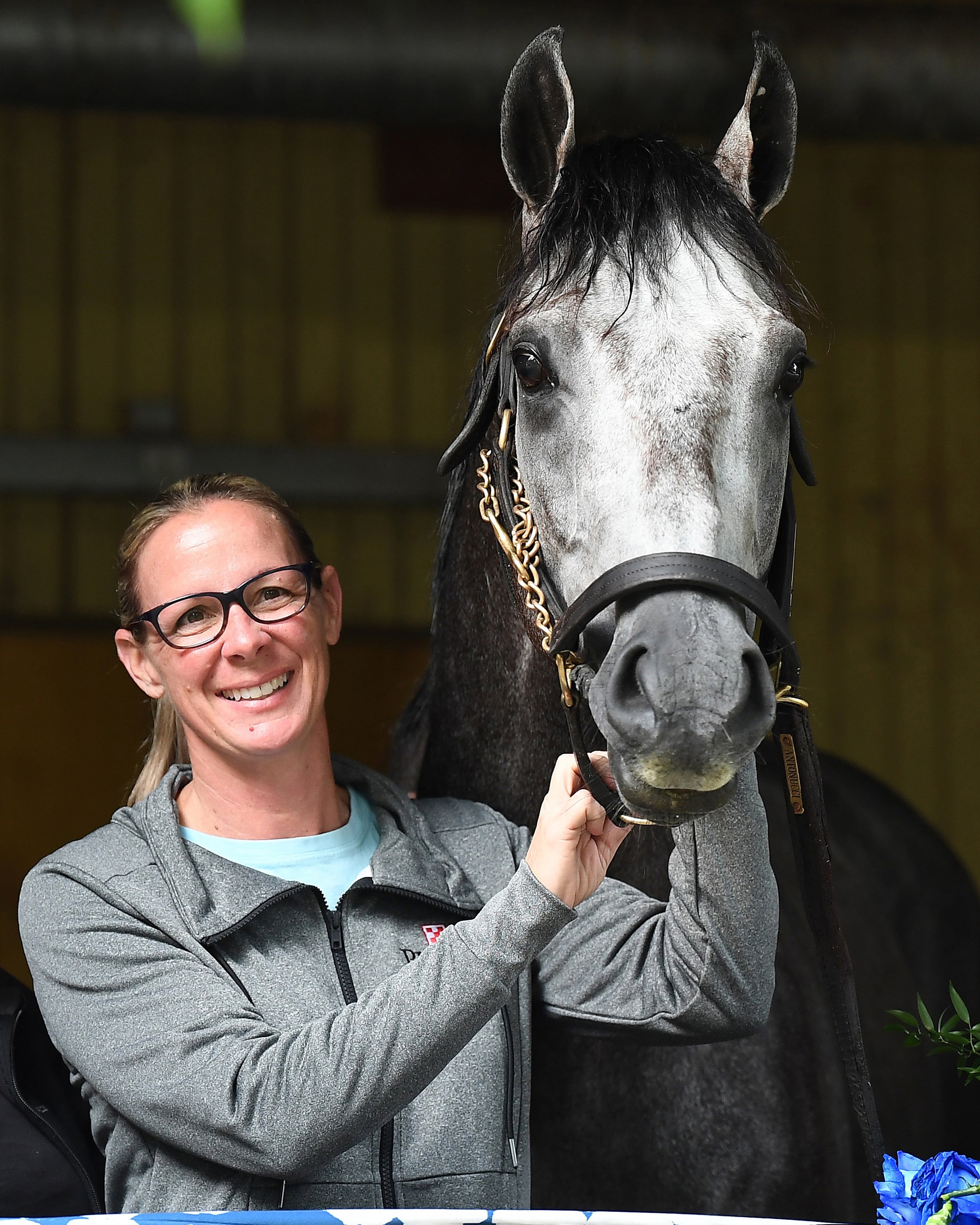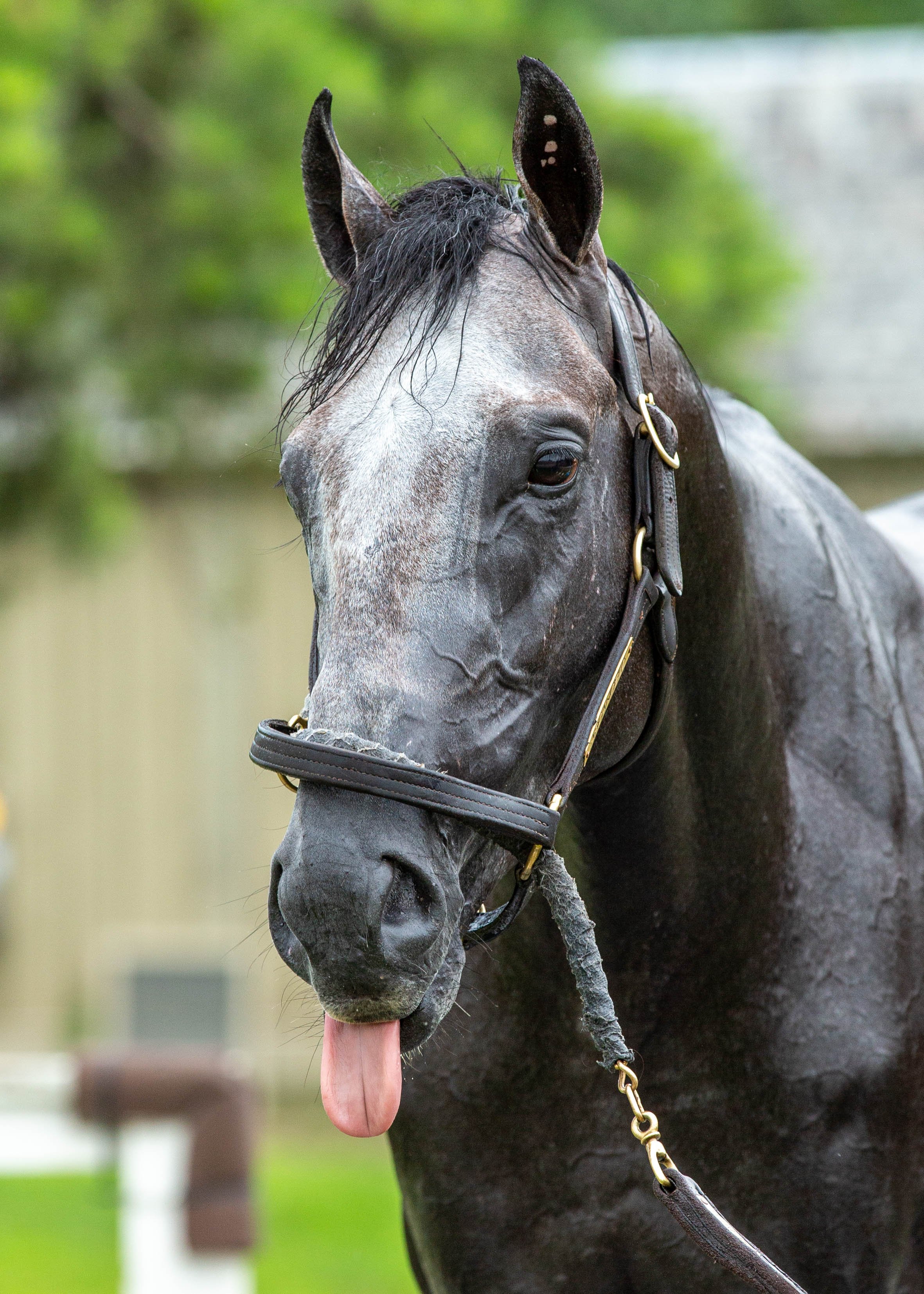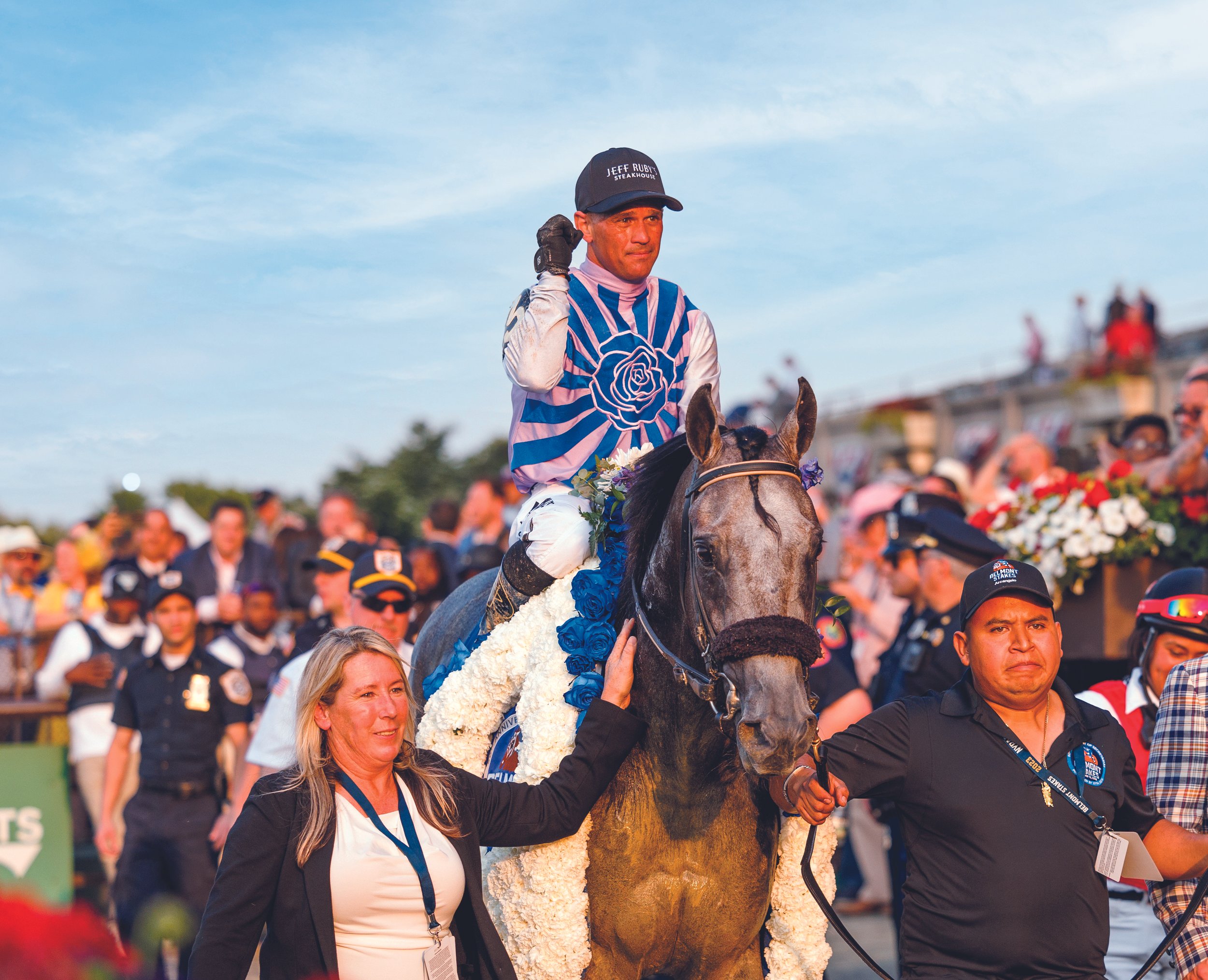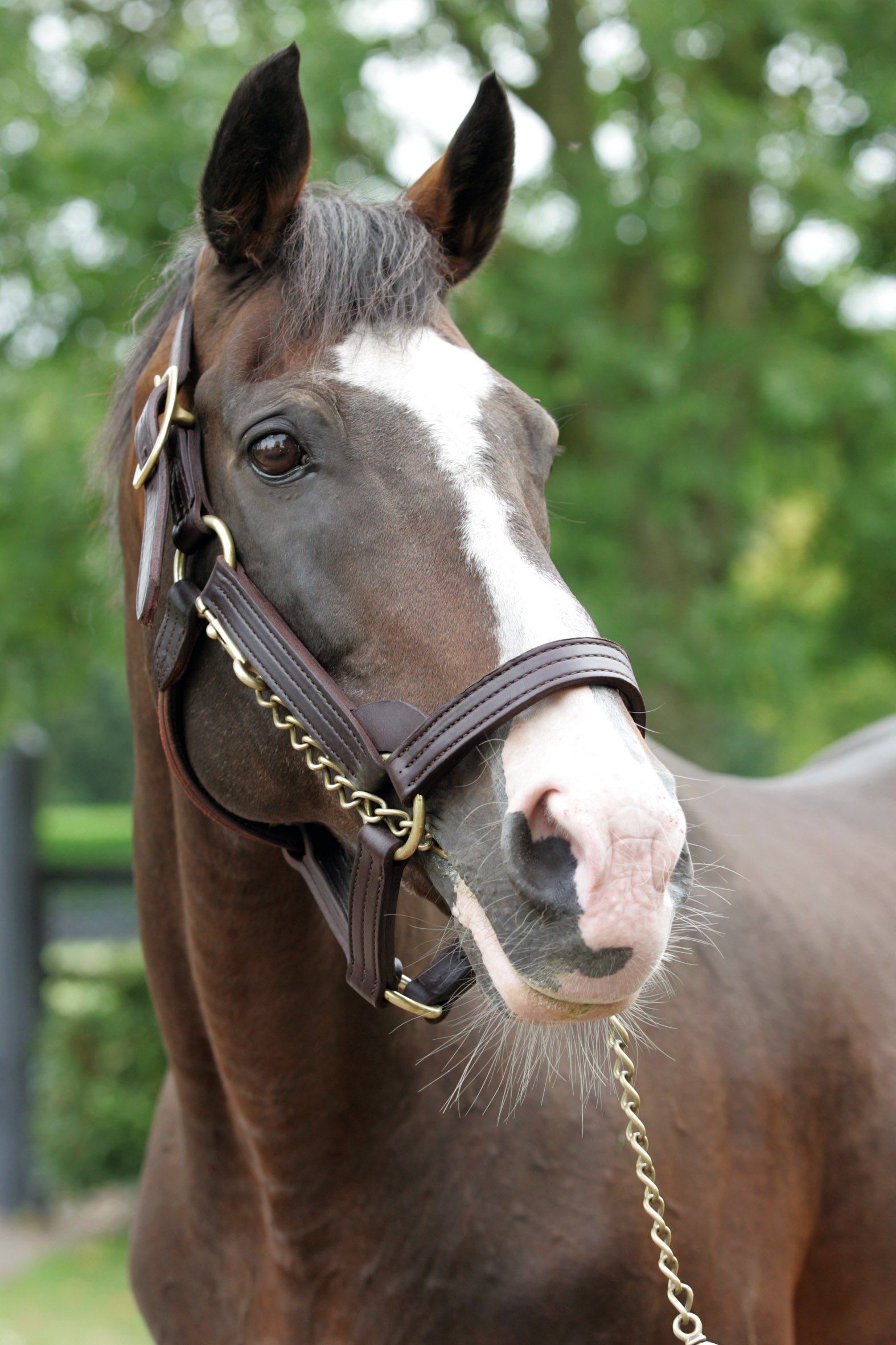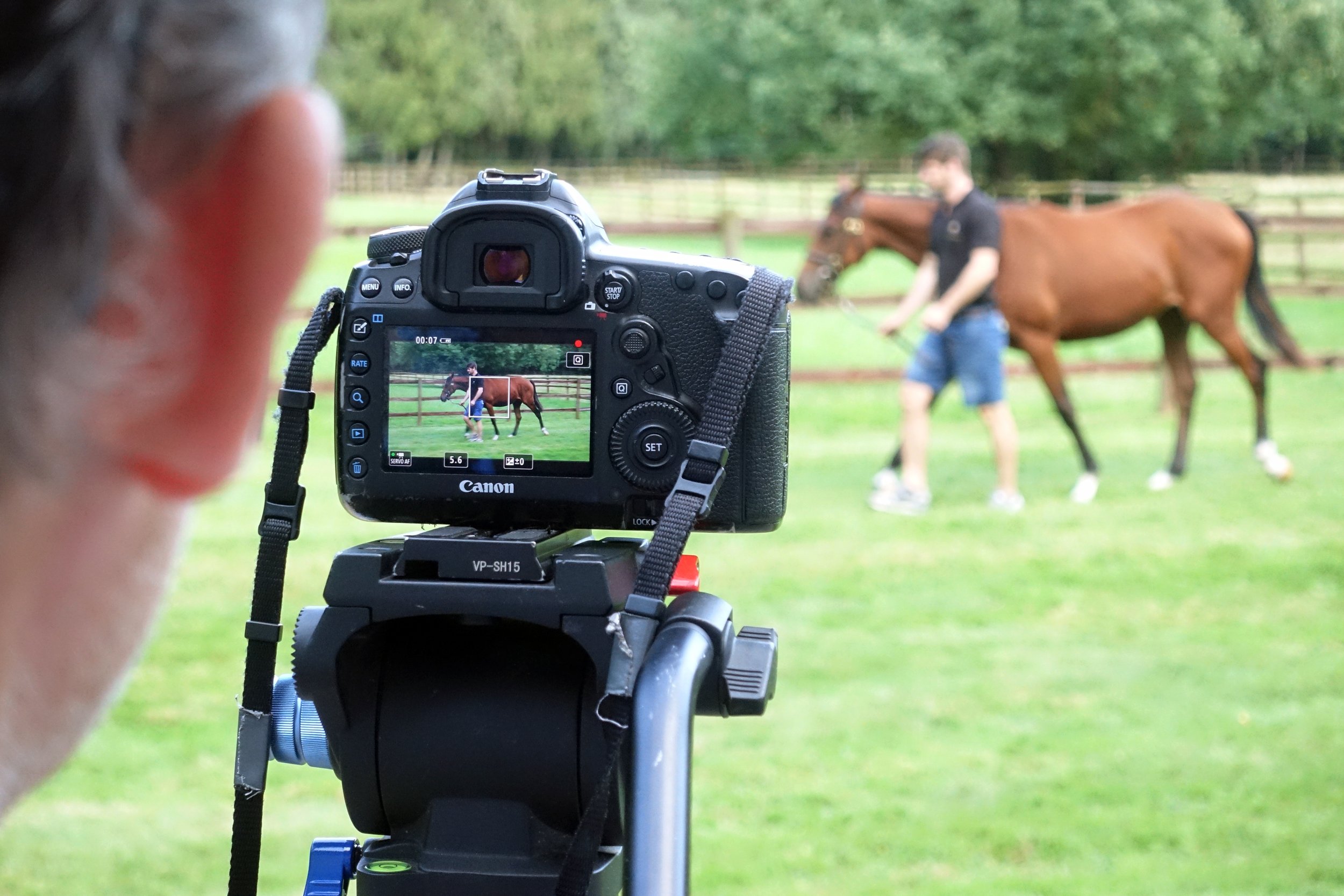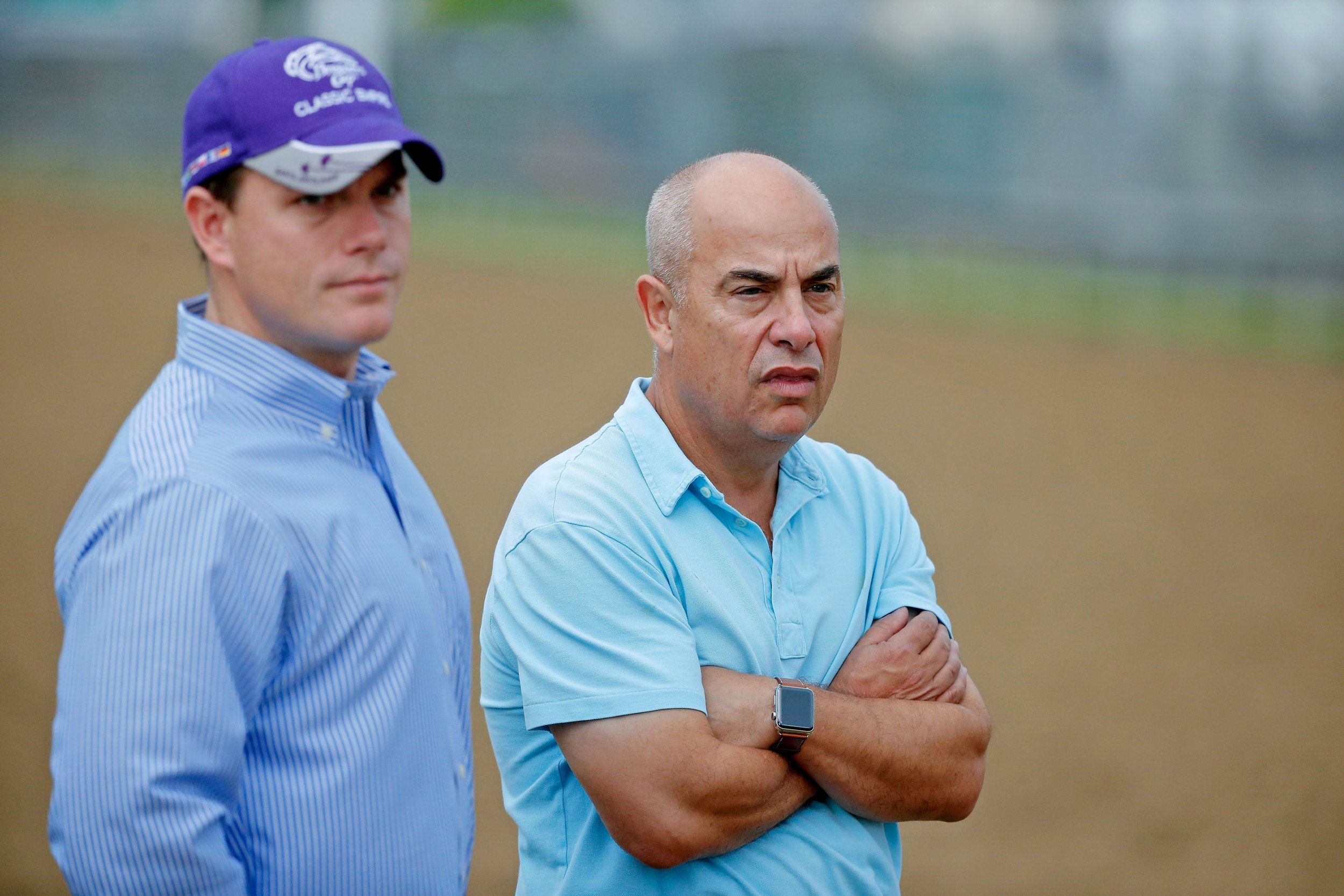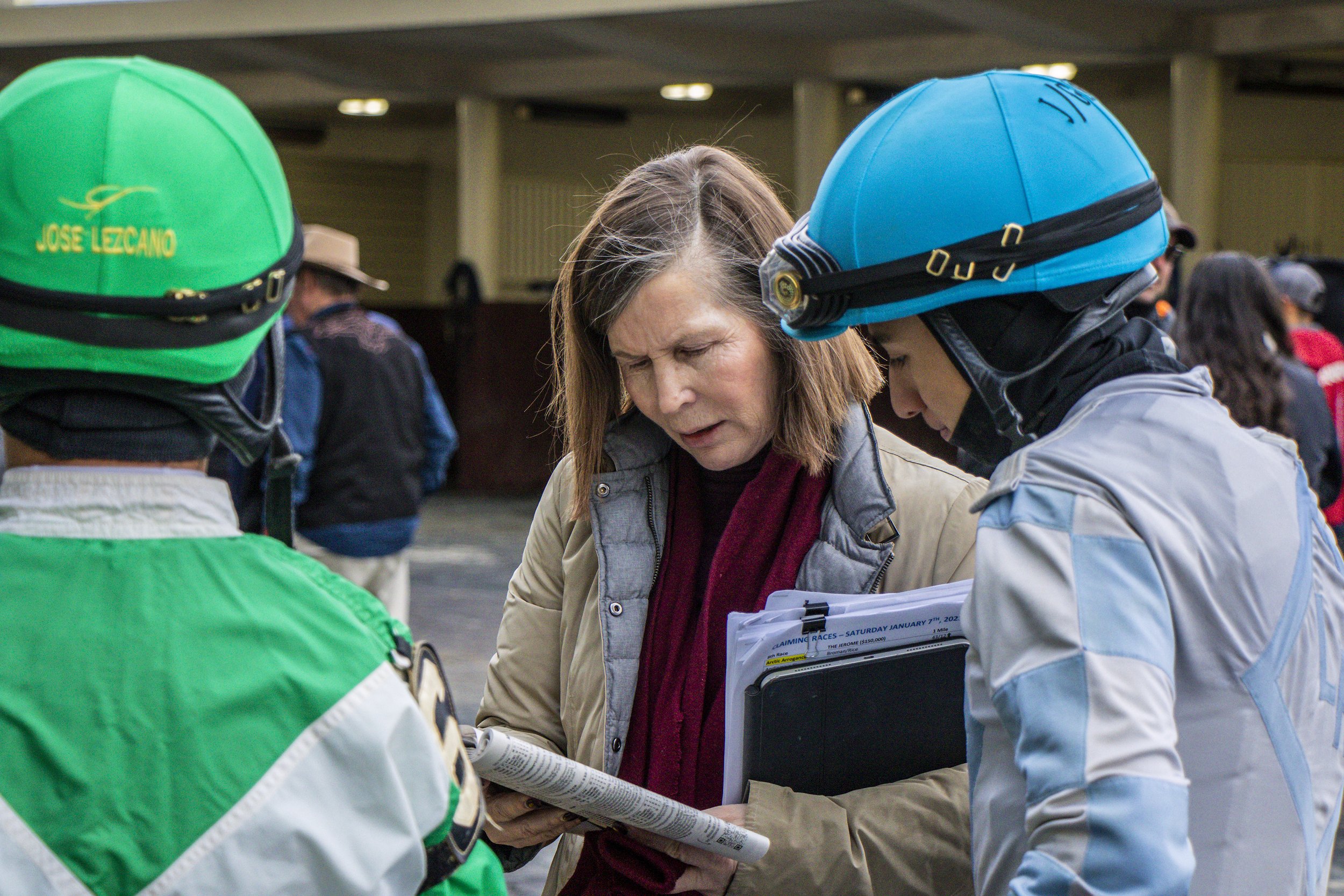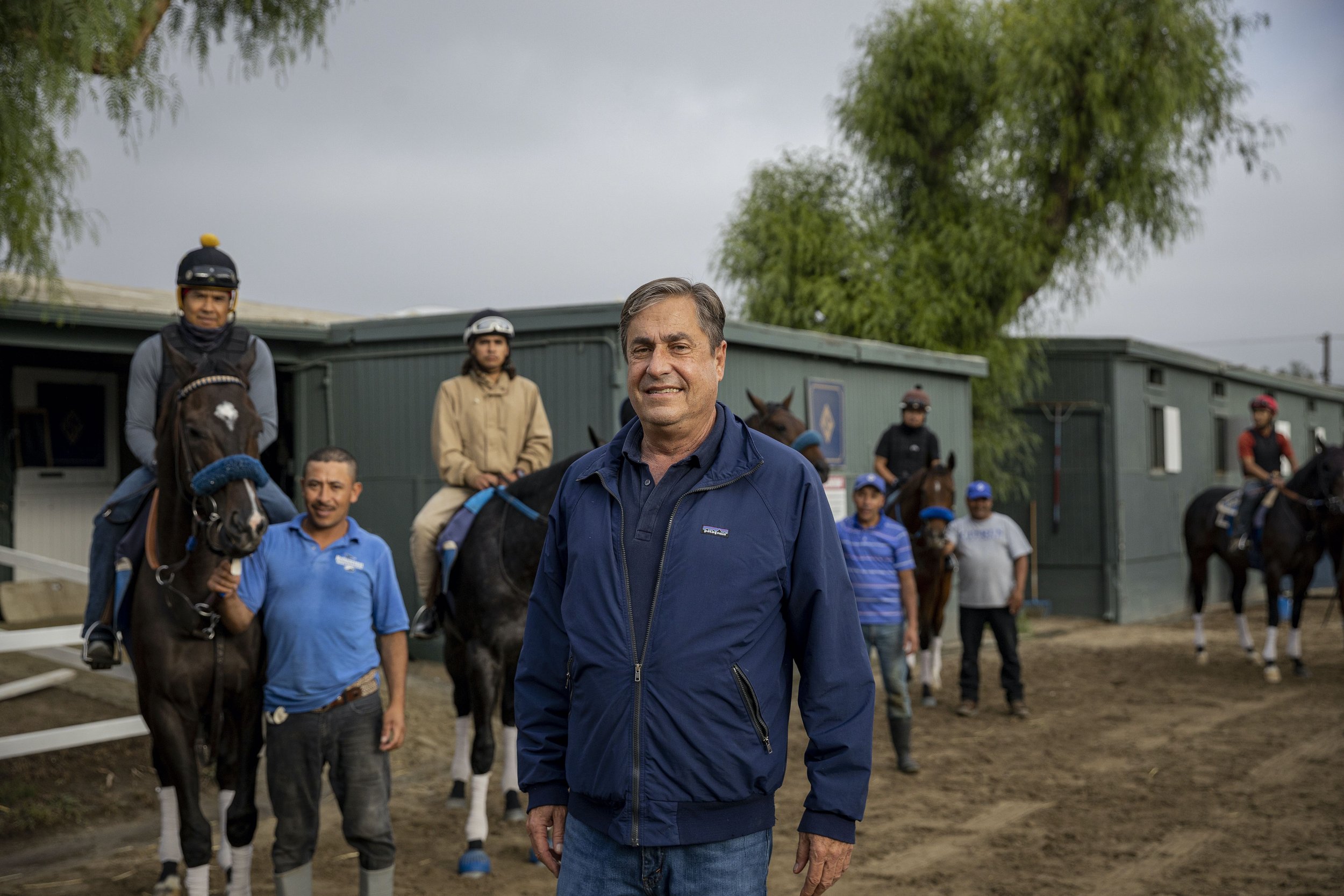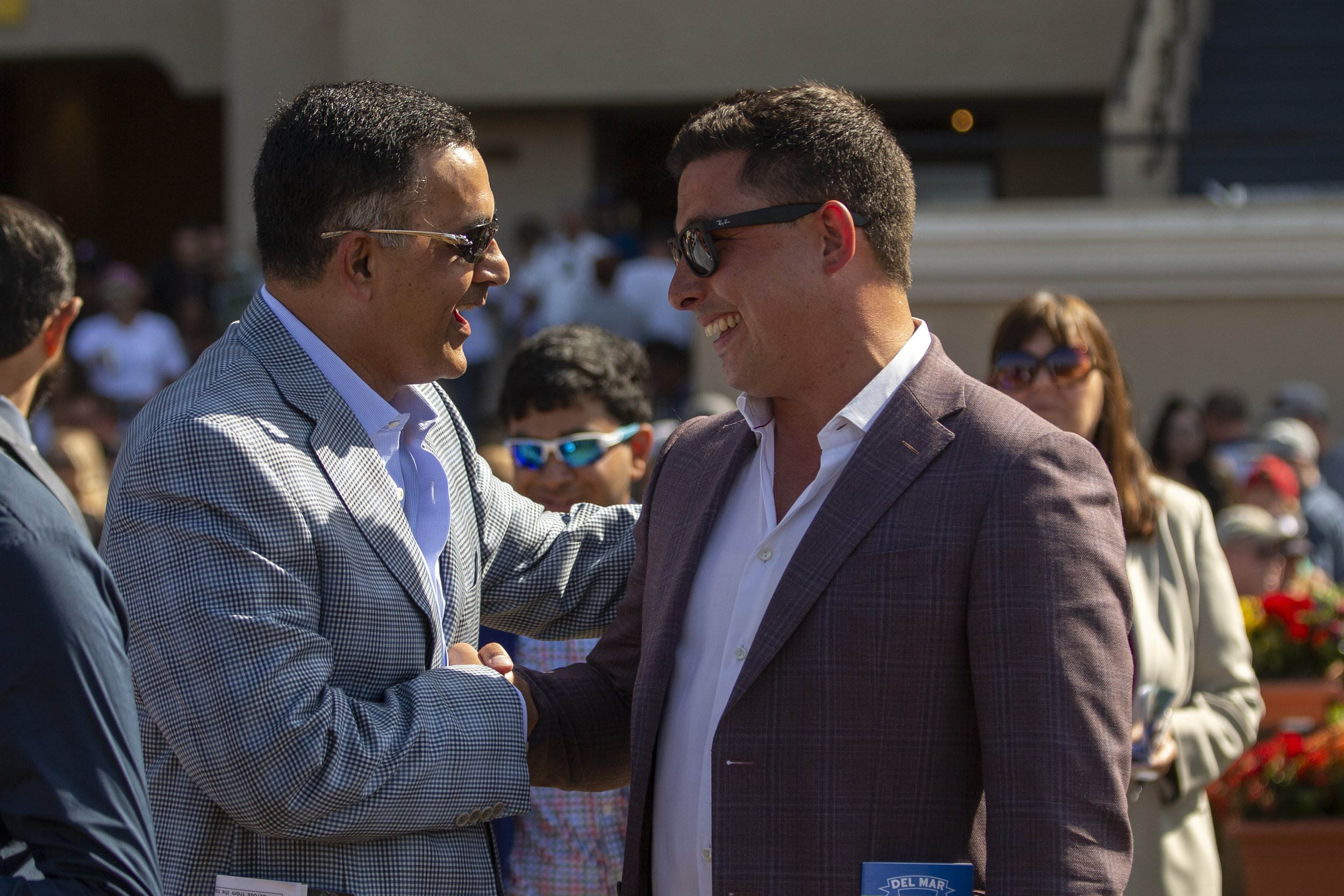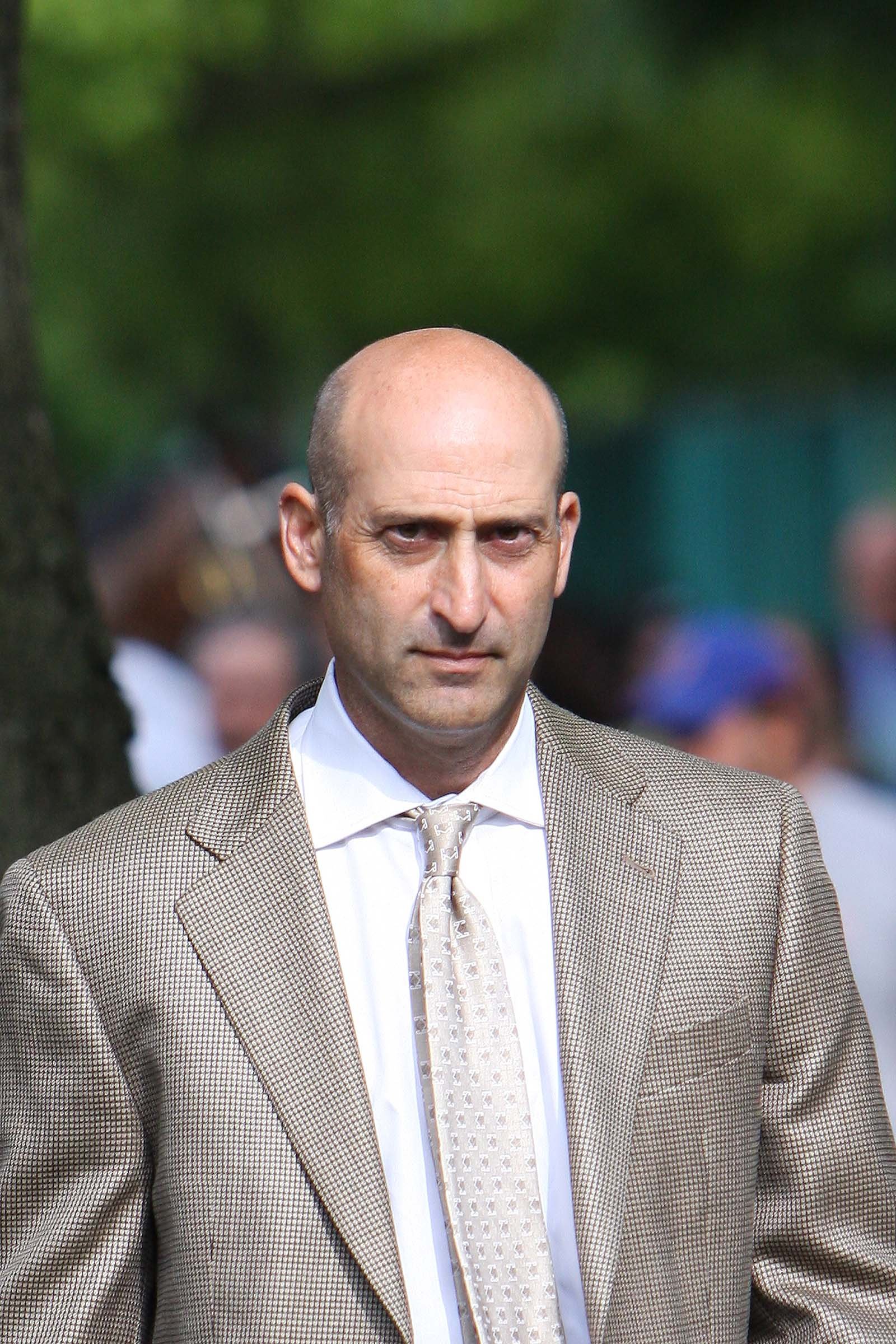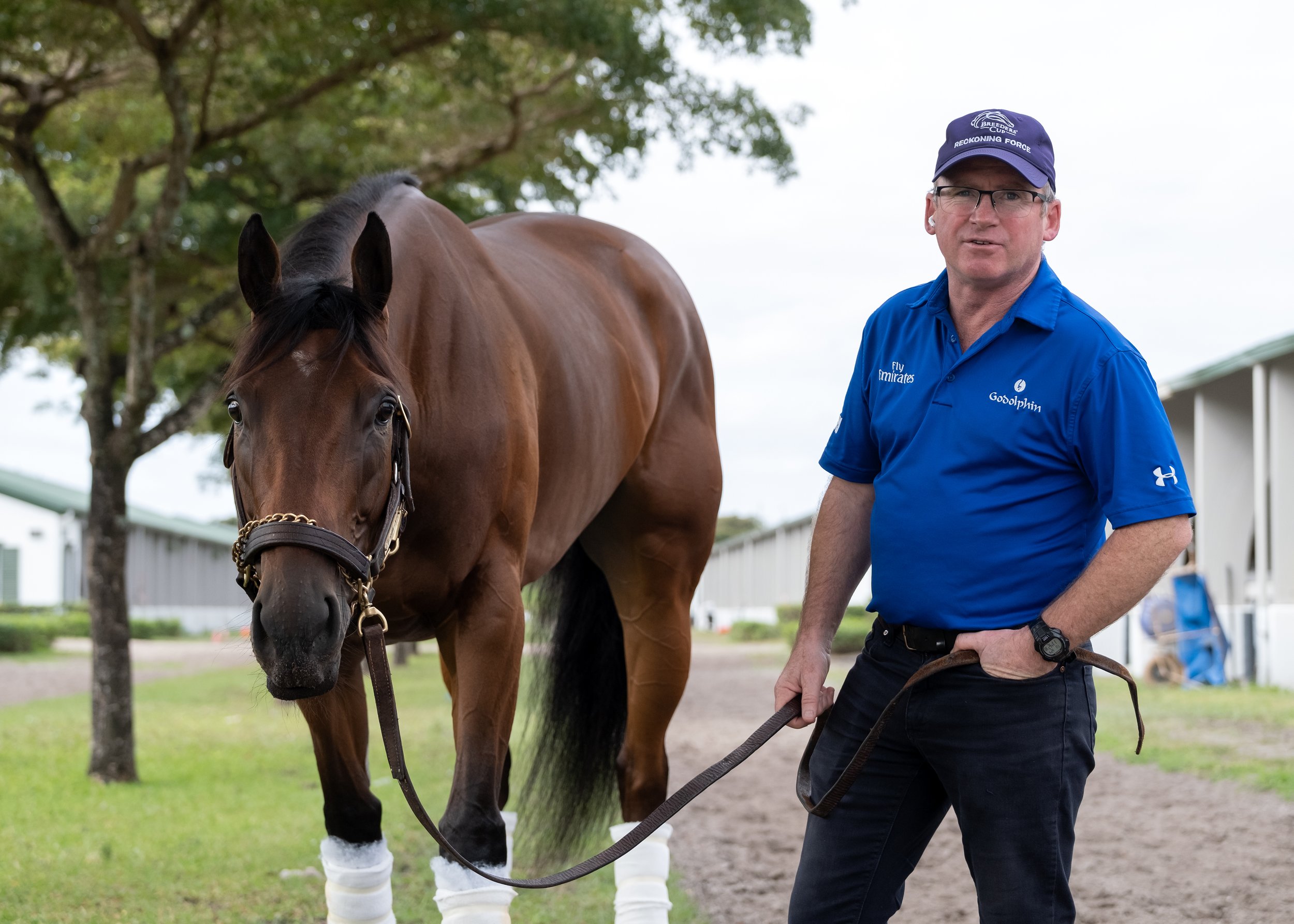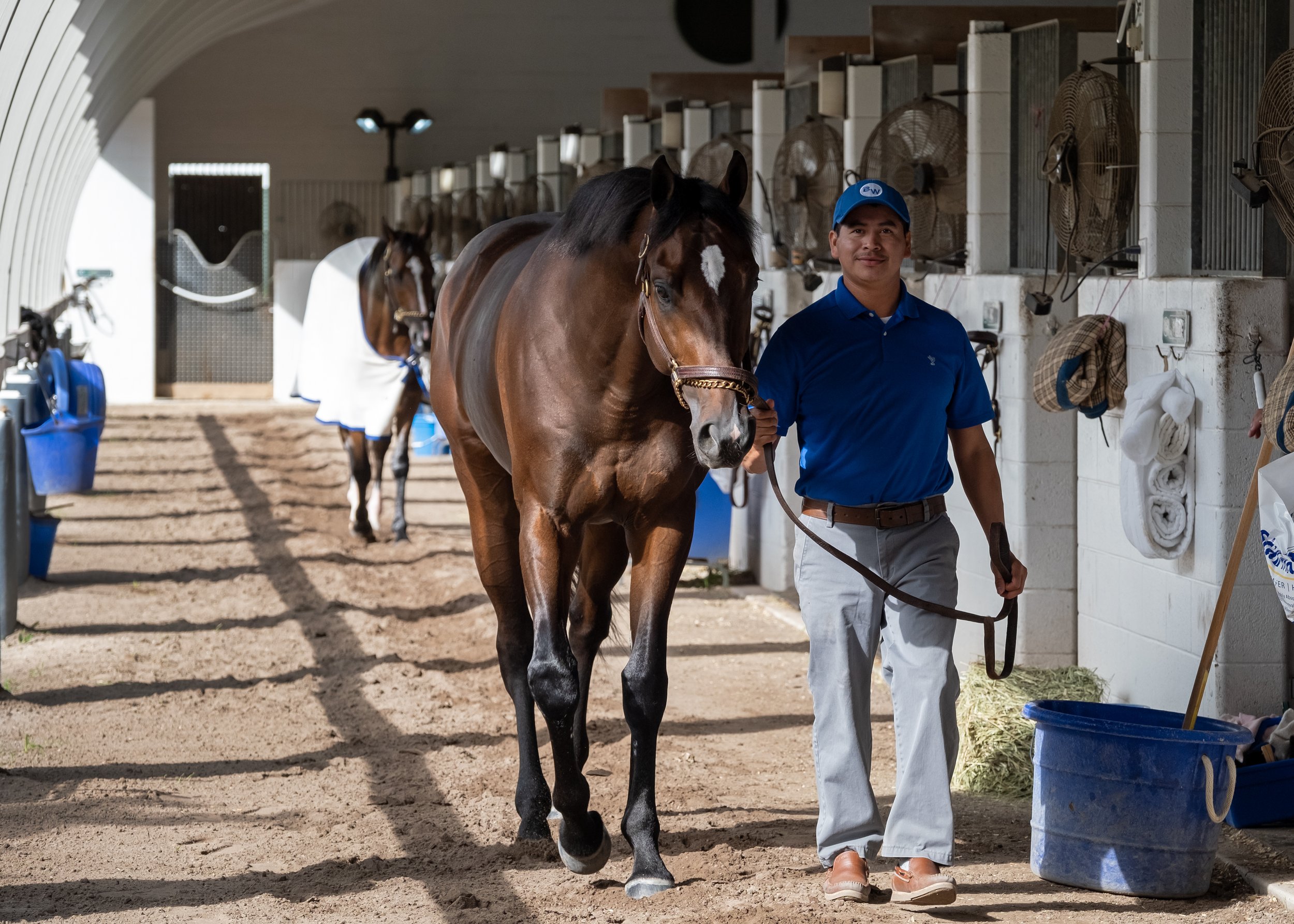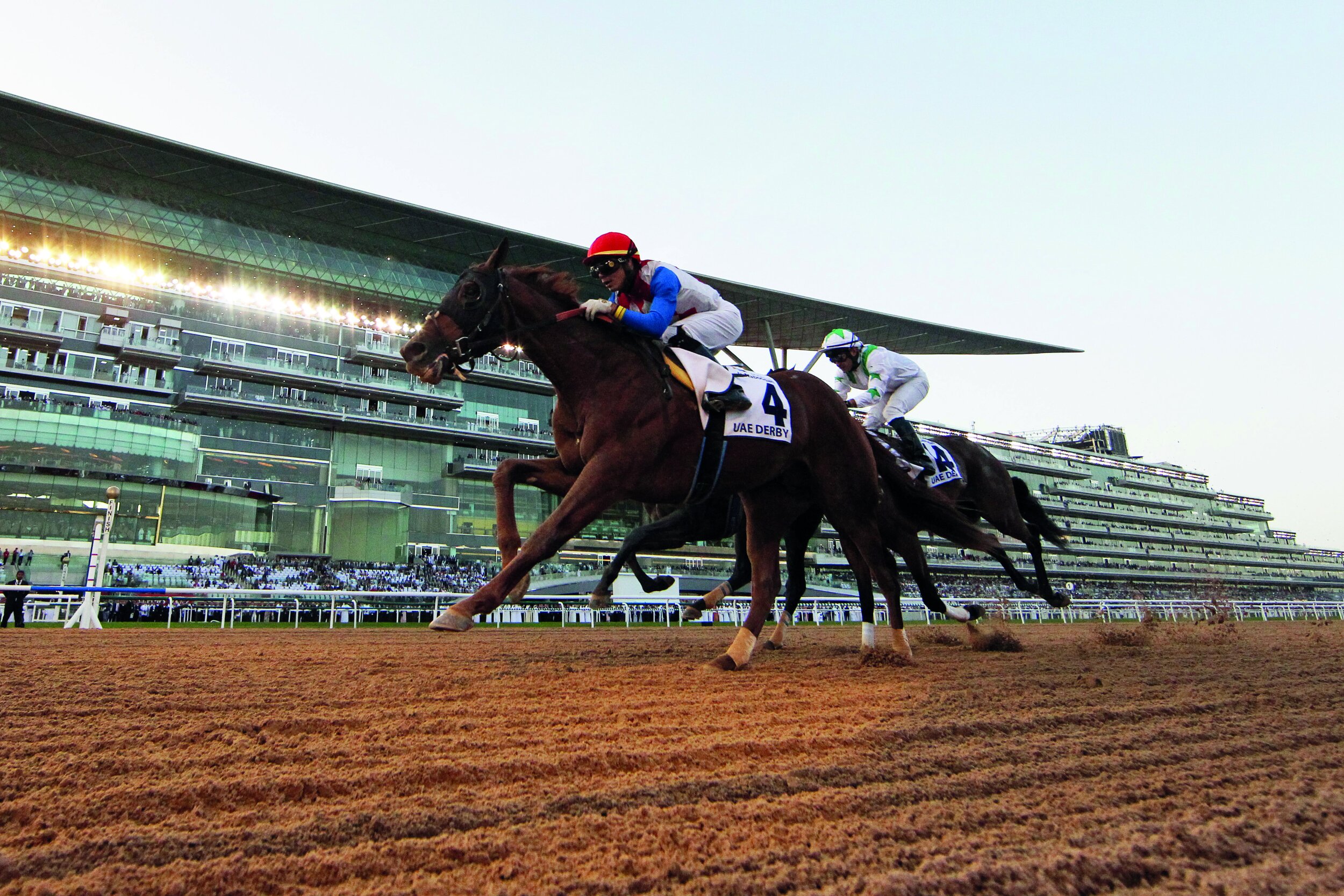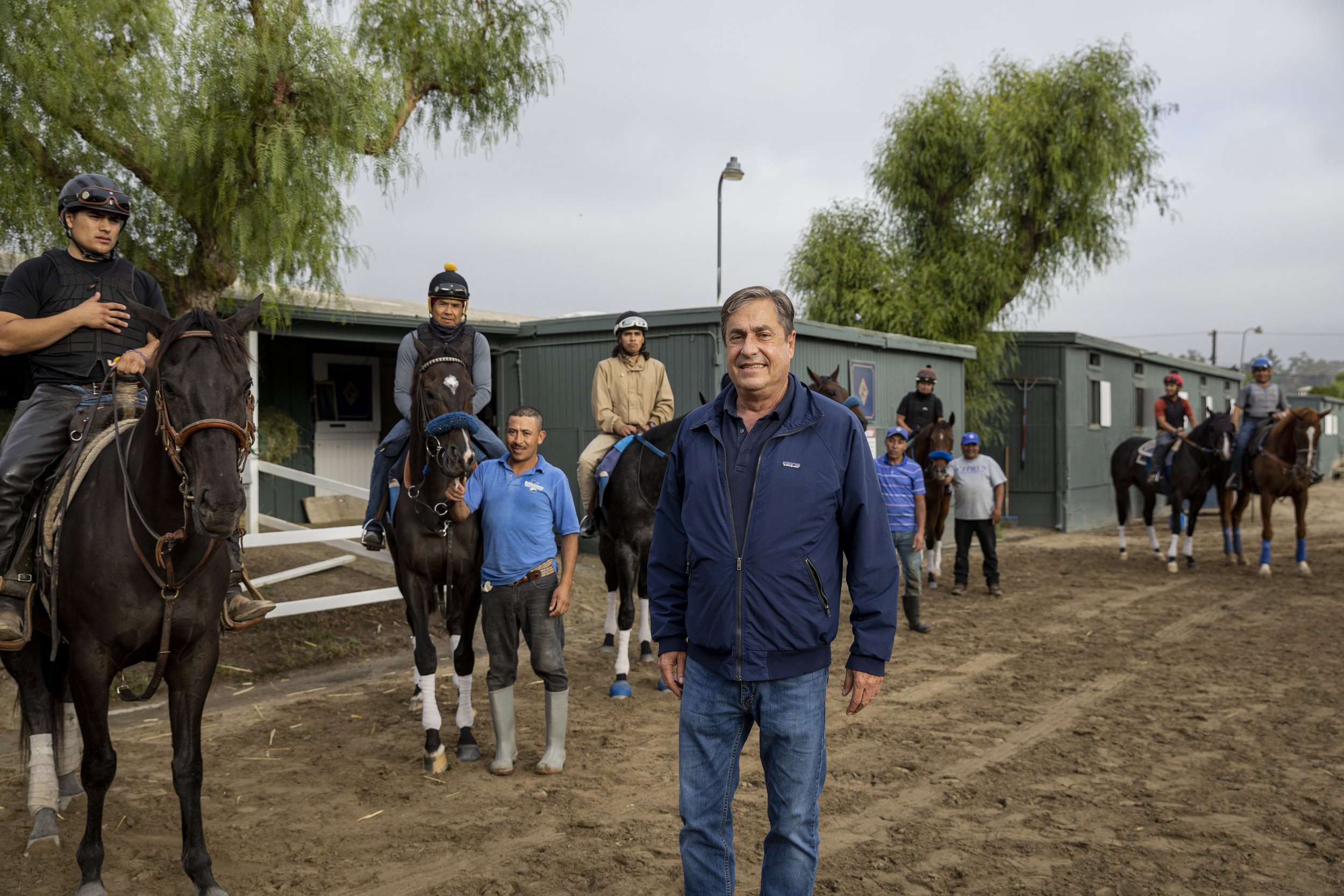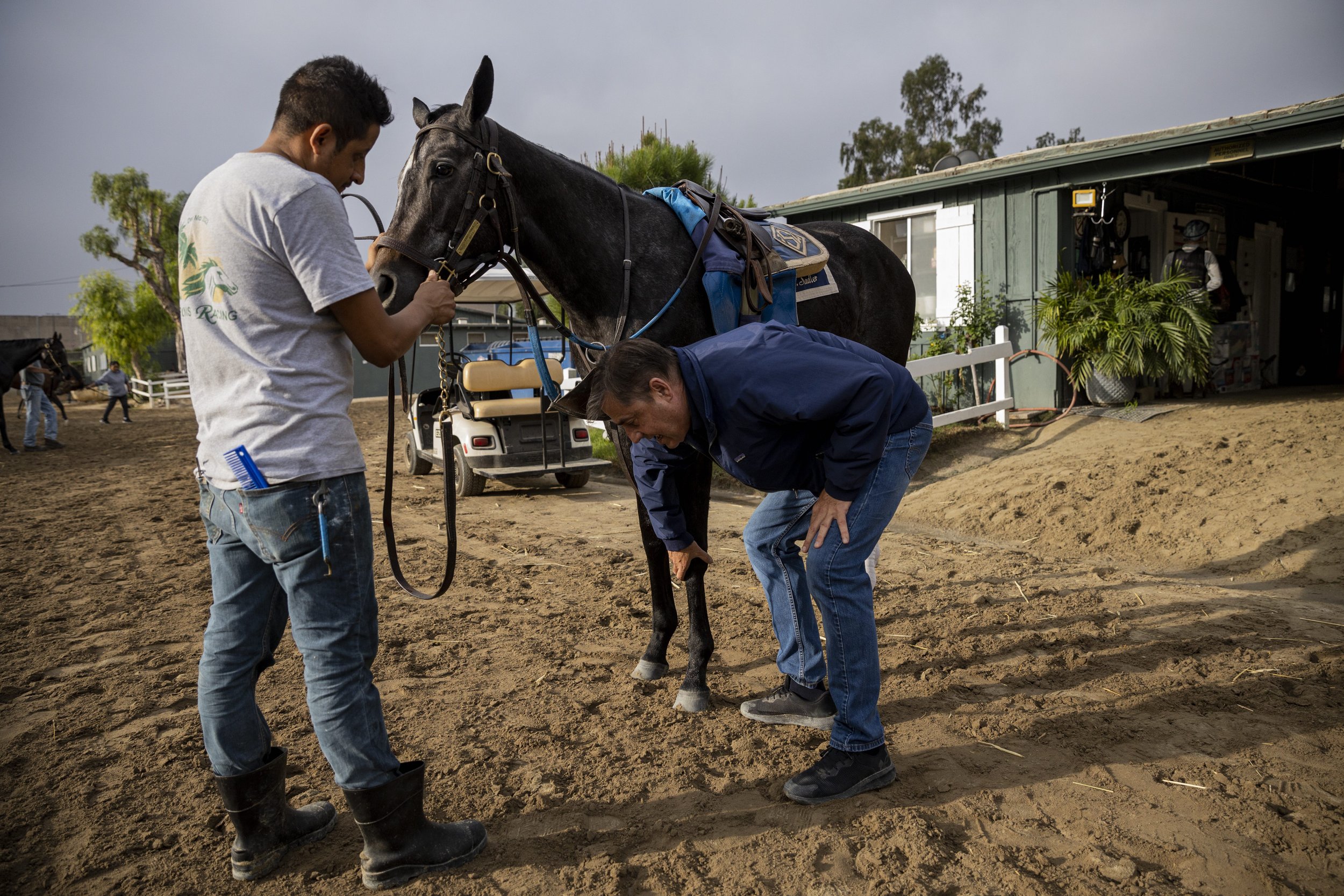Jena Antonucci - trainer of the star 3yo of 2023 - Arcangelo
Words - Ken Snyder
In the media avalanche surrounding Jena Antonucci, after her summer to remember, there is both rich irony and something very telling in one of the three “things you didn’t know” about her that escaped attention: she competed in shotgun shooting events. Those close to her who didn’t know this might say, “That figures,” or “I’m not surprised.” Shooting takes focus and concentration, both of which are in Antonucci’s DNA.
The next thing they would say is probably “I bet she kicked ass.”
Her parting words in an interview on YouTube the morning of this year’s Belmont? “Let’s go kick some ass.”
She does not fit the mold of a Thoroughbred trainer. If “focus” and “concentration” could be scored and put into some kind of competition, she’d likely kick ass in that too.
The two other “things you didn’t know”: she is in her own words a “very good golfer, but without much time to play.” The third thing? She is hesitant to admit that “she doesn’t drink coffee.”
Mold breaker might be an apt description of Antonucci in her handling of success. The example is her response as a small- to medium-size trainer.
“Our number one goal is always wanting to be in the thirty- to thirty-five range, and that’s where we’re focused on staying,” she said. In a purely commercial sense, that’s saying no' to a flood of potential new business in the wake of Arcangelo’s success.
Were there calls from prospective owners after the Belmont and Travers?
“There have been conversations, but it’s been a ‘onesie, twosie,’ here and there, kind of thing.
“We’re not looking to be a stable of 150 horses. It’s not who we are. It’s not who I am.”
Antonucci is a horsewoman who rode show horses from age three into young adulthood and then gained not just experience but the right experience with Thoroughbreds. Her first foray was breaking and galloping them at Padua Stables in Ocala, Florida, where she now lives. She was then a veterinary assistant for four-and-a-half years, which gave her valuable horse knowledge on the ground. Exercise riding after vet work gave her knowledge up top astride a horse. All-important management experience, a necessary skill in any racing stable, came through her Bella Inizio Farm she opened in Ocala. (“Bella Inizio,” incidentally, translates as “nice start” in English.)
As if that’s not enough, she operates HorseOlogy with co-owner Katie Miranda, a Thoroughbred training and ownership organization that spans raising, training and racing while also offering bloodstock advising, pinhooking, micro-investing and more.
Her start in training was at Tampa Bay Downs in 2010, a year that maybe wasn’t the “nicest.” She won two of eight races and had two second-place finishes. Things began to take off in 2013 with 288 starters and earnings of $1,067,303. This year, of course, Arcangelo has vaulted her into the stratosphere with his $1.7 million in earnings.
“We’ve kind of been the ‘little stable that could’ for a long time,” looking back at her previous ten years of training.
“One thing I’ve always been very proud of is horses who have been claimed off of us or who went to a different barn [and] haven’t gone on to become big flourishing horses. I think a lot of mid-size trainers deserve to be evaluated in that manner, and it’s something I think we fail in the industry to do.”
She has, perhaps, a more realistic take on win percentages for trainers and how she believes they are misinterpreted by not factoring in stable size. Her website even has a section entitled Statistics Aren’t the Only Indicator of Success. “I think you can have somebody at 20 percent if they have 200 horses and can put a million-dollar horse in to get the win.”
Arcangelo broke his maiden third time out at Gulfstream Park and has been undefeated since then. “I think we get stuck in the headlines of ‘Oh, won first out!’ It’s atypical. It is likely that less than a single-digit percentage of the horse population annually wins the first time out. We set owners up for failure.
“I think we do a consistent job across the board. I’ve had to make a lot of chicken soup out of chicken poo; and with that, I think I have the reputation for being a good horsewoman who is thorough and is trying to find the missing piece or what we can to find a horse’s success level.”
The missing piece for Arcangelo was careful parceling of his potential Horse of the Year talent. Antonucci’s racing campaign gave the horse more time between starts than other trainers might have given the son of the late Arrogate.
“I give a lot of credit to John [Ebbert], his owner, for allowing this horse to have space. I would say most, if not all owners, who saw this talent coming would want a pretty aggressive schedule. I give John a lot of credit for allowing this horse to have the breathing room that he needed and not pressuring me and the horse to pick up races on a tighter schedule.”
Antonucci uses an open-door policy to both involve her team of workers and parcel her own insight and skill as a trainer throughout her string. “It’s impossible for me to be able to put a hand on every leg, every day,” she said. The solution is a barn where everyone—whether foreman, groom or exercise rider--is encouraged to speak up if they feel anything has changed with a horse.
“So many exercise riders that come to work for us—it’s such a relief for them to be able to come and be able to tell what they’re feeling. So many trainers and assistant trainers don’t want to hear it. A rider may not know exactly what it is, but if they’re communicating that something feels different, that’s all we need to know.
“I think having a riding background and coming from that avenue into this and not racing per se—and riding for so long—I can see what they’re feeling.
“We don’t ever tell anyone that we don’t want to hear what they have to say.”
There are nuances also in Antonucci’s relationships with owners. “I don’t think we want our clients to go, ‘Whatever you say,’ but I think there’s a balance with the people that believe in us. They know Fiona [Goodwin, assistant trainer]. They know it’s ‘horse first.’ And we’re going to make the best possible results with who we have in our hands.
“I don’t have a problem with owners being tough, but you learn to find a balance with people believing in the program and what we do.”
The intensity she shows to the public in interviews surprisingly isn’t carried into the barn and her help.
“I know she’s focused, and I know that she’s passionate,” said Goodwin, “but she really isn’t intense.” Goodwin has worked for Antonucci from the start of her training career. “You’re running a business, and you’ve got a job to do, so it’s not all fun and games, but we’re light-hearted in the barn.”
Input and an open-door policy might be only one factor in the success of the stable. “Balance” is a word used often by Antonucci to describe her management of people. She uses Goodwin as an example.
“I want my assistant to be able to have balance in her life. It’s what provides us with our life and lifestyle, but I don’t want her here till eight o'clock at night, seven days a week.
“I don’t want the crew run ragged either. When we get to lean in and do what we do in a responsible manner and enjoy the experience and relationships and the personality of the horses, I think we do our best work.”
Goodwin confirms Antonucci’s approach. “She doesn’t want the work to consume us to where we get sour and resentful of the job and industry.”
Arcangelo, personality-wise, is a piece of work himself, Goodwin said with a laugh. “He likes to be ‘cheeky,’” an expression from her native Ireland. It means “playful.” “He’s fun to be around. He’ll take a chunk out of you every now and then if you’re careless around him. He thinks that’s fun—a love bite.”
In one aspect, his personality also parallels that of his trainer, “But when it’s time for him to go to work, he’s very focused and serious about his job,” Goodwin added.
Her advice for other trainers who burst onto the radar with a “big horse,” is to “turn off the white noise, keep doing what you’ve been doing and stay focused on that. Make sure you’re surrounding yourself with the right people and not a lot of people.”
While quantity intentionally will be maintained in her barn, quality is another matter. “Having some opportunity with a higher pedigreed horse or horse that comes in with a little bit more of an ability, our job will be to nurture that and grow that. Hopefully, we will have more talent to hit the track from those opportunities.”
The task will be the same with any future high-priced, impressively pedigreed Thoroughbred—the same as it is for the least expensive horse in her barn; and it is what drives Antonucci: find the answer.
“I don’t believe people will view me as a ‘one-hit wonder.’”
For those like Goodwin, who has been with her the longest of anyone in the barn, it won’t be a surprise to see her back in the spotlight at some point in time, probably sooner than later.
“If she were in any other business, she would be a success and probably at the top,” said Goodwin. “She knows what she wants, and she goes after it. She does the job right. It’s always her goal to do better, be better, and win races. If you’ve got the horses, you can do it.”
The horses would be the question, as it is for any trainer, large or small. Arcangelo sold for $35,000 at the 2021 Keeneland September yearling sale—a small fraction of the price for top sellers annually at this premier sales event.
She got a fair amount of attention from those at this year’s sale and recognizes she is a banner carrier for many women in general, but especially in racing. “I’m very grateful for what it means to them and their journey. From an old hard boot to a young female, it’s pretty remarkable.”
For Antonucci, it’s competition with no thought about gender. “Who can train a horse better than the next person?” said Goodwin. “I think Jena thinks of it that way. We’re not intimidated by any other trainer, male or female. We’re here to win, and that’s it.”
Goals? Antonucci may have something to offer the entire world with this: “I think goal setting should be on how you want to live your life and the accomplishments that come with that.”
Opportunities afforded by Arcangelo come second to his life. “Whatever opportunities it provides me will be secondary to stewarding him through his career.
“My goals are to continue to work with great people, foster relationships that are around me, have a healthy growing business in HorseOlogy, have a healthy business at the racetrack, and make sure that the relationships with the people around me are thriving. Everything else becomes secondary.”
And oh yes, another thing: kick ass.
Fiona Goodwin - Jena Antonucci’s assistant trainer
Much of Fiona Goodwin’s Irish accent has been worn away by 27 years in the U.S. Laughter, however, is without accent and nationality; and you hear it often with Goodwin.
It’s probably more often than usual in the wake of Arcangelo’s success.
She has been the assistant trainer to Jena Antonucci for 15 years from Antonucci’s first day as a trainer.
There was poignancy in Antonucci’s attention to Goodwin’s place in win photos after the Belmont and the Travers. It appeared important to Antonucci that her assistant was in a prominent place in the photo and indicative of a close relationship beyond boss-employee.
“We were first friends in the beginning, and we have remained friends,” said Goodwin. “I would say I’m as close as anybody to her.”
The “business relationship” in the barn is also a close one. “We’ve been doing this together so long, I know exactly how she trains, what she expects and what she expects of me.”
Goodwin and Antonucci first met at Saratoga when Goodwin was in James Bond’s barn where she had worked for 10 years as a forewoman. Before Bond, she worked in the barns of Nick Zito, Mark Henning, Eddie Kenneally and Linda Rice. And those are only the ones she can recall, she added with a laugh.
“On the racetrack, you work for everybody.”
Goodwin comes from a horse family in County Kerry and is one of sixteen children—ten brothers and five sisters. (She is fourth in the birth order.) Her father was a showjumper, and the family always had horses for that event. A brother is also a showjumper, and two others are jockeys—one in Ireland and the other in England as well as Sweden, Italy and Norway.
Surprisingly, Goodwin had no interest in Irish racing growing up. “I was more into show horses.”
That changed when she visited a brother working at a horse farm in Franklin, Kentucky, near Kentucky Downs. The visit became permanent when she started riding at the farm. When her brother left to go to the Fair Grounds in New Orleans and a job with trainer Eddie Kenneally, she went with him.
“You can’t go anywhere alone when you’ve got ten brothers,” she said with a laugh.
“I’d never been on the racetrack. He was going there, and I thought, just let me go along. I actually started grooming, which I wasn’t a huge fan of.” Shortly after, she exchanged her rub rag for reins and exercise riding. “Been on the racetrack ever since.”
Today, she shuttles back and forth between Antonucci’s stable at Saratoga, Gulfstream and Antonucci’s Ocala, Florida operation. Currently, there are twelve horses at Saratoga and “sixteen, maybe seventeen,” she said, at Gulfstream. Arcangelo is already at Santa Anita, the site of this year’s Breeders’ Cup where he will run in the Classic.
The Antonucci stable is a family affair, of sorts, for Goodwin. Her husband, Robert Mallari, is an exercise rider and is Arcangelo’s regular workout rider and has worked for Antonucci almost as long as his wife.
More articles from this issue include:
Following in Their Footsteps: Lessons in Business & Training Passed Between Generations
The story of horse racing is one of families. Usually, the conversations focus on the equine kind, sires and dams, and what the generations listed in each horse’s pedigrees bring to the athletes at the center of the sport. The human side of racing too features the age-old tale of family legacies as knowledge and experience gained by one inspires the next to join the fray.
Whether the name is Hirsch or Veitch, Bryant or Casse or Mandella, the training side of the sport has its share of families passing both knowledge and experience down to the next generation. Summers spent mucking stalls and caring for horses allow parents to share hard-earned expertise with their children, and, in turn, move them to follow in their footsteps. Their journeys to striking out on their own may mirror the ones the previous generation undertook, but the challenges that each face are ones that reflect the changing times within the sport.
The Mandellas
As the son of a blacksmith, Hall of Fame trainer Richard Mandella grew up with horses, seemingly destined to make his life about their care and training. He assisted his father Gene on their California ranch and learned to break and ride horses from an early age. Dreams of being a jockey turned into time in the saddle as an exercise rider and then years in the barn as a trainer, finding success with horses like Dare and Go, Kotashaan, Omaha Beach, and Beholder. When it came to his two children following in his footsteps, the California-based Mandella, who has been training for nearly five decades, found son Gary eager to join the family business, but the fatherly side of the Hall of Famer tried to dissuade his son from going that route.
“We were walking out to the parking lot one day, and I asked him, ‘What are you going to do when you finish school?’ And he looked at me and said, ‘I’m going to do what you do, Dad,’” Mandella shared. “I couldn't chase him away. I wanted him to get a real job. He didn't like the idea and worked for me.”
Gary, on the other hand, followed through with his father’s request that he go to college and even tried broadcasting for a time. “I feel very fortunate that people tried to open my eyes to remind me what else was out there, that I could look into something else and try this, try that,” the younger Mandella reflected. “But I knew before I turned 16, that it was going to be hard to get away from [training].”
His foresight about that career choice came from years growing up with horses right outside his window. The family had a small farm where his dad would send horses for some downtime, meaning that the younger Mandellas were working with and caring for these athletes from their earliest years. “I woke up, and every window that I looked out of my bedroom, I saw horses,” he remembered. “Just helping take care of them there and having the opportunity to be around them all the time made [me] want to be a part of that.”
Those experiences working with his dad and his horses on their family property as well as on the racetrack brought Gary Mandella the background he would need when he decided that a trainer’s life was for him. “My father’s always been more of a lead by example than make a big speech kind,” the younger trainer observed. “He showed me, expected me to pay attention, and was always clear about what the priorities should be.”
The Bryants
George Bryant started his career in the saddle, riding Quarter Horses for more than a decade, but, when age spelled the end of that career, he parlayed his lifetime with horses into training. Based in Texas, he worked first with Quarter Qorses and later Thoroughbreds, retiring in 2021 as son George Allan Bryant faced a fight for his life.
Diagnosed with stage four oral cancer, the younger Bryant battled through surgery, chemotherapy and radiation, coming out of the experience determined to follow through with his goal of becoming a trainer like his father. He had delayed starting his career until the elder Bryant stepped away, instead working as a racing manager for HDT Allied Management, hosting the Horse Racing Destination podcast, and serving as a member of the Texas Thoroughbred Association.
His decision to open his public stable and start his training career was a long overdue one in the eyes of the elder Bryant: “He’s been ready for quite a while now, [but] it was up to him to make the decision. He really didn’t want to go into training until after I retired.”
“I didn’t want to compete with him,” George Allan Bryant shared about his decision to defer his training career. Though he did not start his own stable until 2022, the younger man watched and learned from his father, always accompanying the elder Bryant to the barn and riding horses at an early age. This hands-on education prepared the younger Bryant so well that he passed his trainer’s license test on the first try, and then got on social media to share that he was ready to open his stable. He got his first client, Mike Powers, not too long after that.
Now, his barn at Sam Houston Race Park in Houston counts 20 horses, with the elder Bryant by his son’s side as his assistant, building on the determination that got him through his fight with cancer and pushing him forward.
The Casses
Mark Casse’s own roots in racing come from his father Norman, one of the founders of the Ocala Breeders’ Sales Company whose Cardinal Hill Farm in Marion County, Florida, gave Mark hands-on time with horses from his earliest years. As a 12-year-old boy, the future Hall of Famer accompanied his father to the 1973 Kentucky Derby and decided to become a trainer after watching Secretariat’s record-breaking performance. It was during those formative years that he learned what it took to become a trainer.
“You learn from many places. I was running my dad’s training barn when I was 15,” Casse recalled. “I learned from grooms, from hot walkers, from exercise riders. You learn because you love it.”
In 1979, six years after that fateful encounter with Secretariat, Casse got his first win at Keeneland in Lexington, Kentucky, and his first stakes win at Sportsman’s Park near Chicago at just 18 years old; but success at the highest level was still to come. In the late 1990s, he moved his base to Woodbine in Toronto, Ontario, and added racing north of the border to his resume. In the meantime, his oldest son Norm was growing up surrounded by family in the sport, with both of his grandfathers and then his father all involved. But his love came more from his childhood in Louisville, Kentucky, growing up with all things Derby.
“I just fell in love with horse racing just because I was here and how much the Derby meant to the community,” Casse shared. Much like his dad, Mark’s encounter with Secretariat, Smarty Jones’s Triple Crown run in 2004 spurred the younger Casse’s desire to become part of the sport: “There was just something about that horse in particular that just really excited me, and it was [then] that I decided that’s what I wanted to do.”
The younger Casse was in his early 20s when Smarty Jones came into his life, playing baseball at Bellarmine University with an eye on what was next: “I figured that I wasn’t going to be good enough to be professional by any means, but I always thought maybe I would be a coach.” After graduating from Bellarmine, Norm joined his dad’s stable in 2006, getting an in-depth education about training horses after years where his focus had been outside of racing.
“I was behind the eight ball when I first started,” Norm observed. “The intention was always going out on my own, but I knew it was going to take at least 10–12 years before I was going to be comfortable and ready.” Before he went out on his own in 2018, the younger trainer managed strings at American racetracks like Saratoga and Keeneland while the elder Casse focused on his Canadian stable—experience that mitigated the growing pains other trainers face when starting their own stables.
With his first Kentucky Oaks starter, Southlawn in 2023, Norm Casse continues to build on the lessons learned working with his Hall of Fame father and finding success in his own program with horses like Pretty Birdie and Rhyme Schemes in his barn.
The Challenges of the Business and Sport
For the Mandellas in California, the challenges are two-fold. A declining population of horses and the rising costs of maintaining a stable make that circuit a tough place to race. “There’s just [not] near the number of stables here as there used to be,” the elder Mandella observed. He let Gary know that the option to leave California and train elsewhere was there, but “[Gary] decided to stay put.”
According to the younger Mandella, the purse money that tracks in California have to offer has not kept pace with what tracks backed by casinos have to offer. Because of that, plus the higher cost of living in the state, the circuit lacks a middle. The state’s racing scene is still strong at the top, as evidenced by the success of West Coast horses coming east, but the inflated prices of real estate and feed make it harder to maintain a barn of allowance and claiming horses.
The younger Mandella has his own stable but shares a barn with his father as well. The two work together, as the Hall of Famer has scaled back his operation, happy to have his son on hand to help guide both stables through the implementation of HISA (Horseracing Integrity and Safety Authority) regulations and the growing dependence on technology. “I’m lucky I have had this barn for 49 years, and I’ve got some great people that work for me,” the elder Mandella shared. “Having him along with it makes it possible for me to get through all of this new stuff.”
Technology makes it easier to communicate with owners and to work with larger ownership groups like My Racehorse, which the Mandella barn has found success with; but it also opens up another set of challenges for the sport. As Mark Casse pointed out, social media has made sharing information, like win percentages, easier, which can be a double-edged sword.
“Everybody wants you to win at a high percentage, and that’s a challenge; and then any little move, any little thing that goes wrong or right shows up on social media, which is tough,” he observed.
Additionally, social media has also led to continued scrutiny from many different directions, especially in light of the recent charges against Jorge Navarro and Jason Servis. “It’s the reason why I have pushed so hard for HISA,” Casse shared. “I want my kids who choose to make this their business to be able to do the right thing and to be on a level playing field.”
For the father-son Bryant team, the biggest difference between starting in the 1980s and in the 2020s is the cost of labor, supplies, and the horses themselves. “It’s gotten to be pretty expensive,” the elder Bryant observed. “When I started, a bale of hay was probably $1.50, and now it’s $20.”
To succeed, “you got to be pretty business smart, and you have to have owners that pay you good,” he said, a sentiment echoed by Gary Mandella.
“This is one of the few businesses where you post bills for services rendered as opposed to pre-billing,” the trainer observed. “When you’re operating with a high overhead, it can be stressful. You have to manage that stress so that you’re just taking the horses in consideration as individuals.”
Balancing the needs of the horses with the needs of the business remains a vital part of the job of horse trainer. While each considers what their horses need, they also need to look beyond the day-to-day care and maintenance to the evolving issues of bringing both new owners and new horses to their barns.
The Search for the Next Big Thing
High up on the list of challenges for trainers is bringing in both new owners and new horses to their barns. The advent of social media as well as the rise of partnerships and microshare syndicates means that the way that the sport conducts business has changed and the men and women who make their living in it must adapt as well. While the opportunities to work as a private trainer for one or two owners may be fewer, these father-son tandems must navigate the continuing evolution in both recruiting owners and finding horses to train.
For George Allan Bryant, social media has allowed him to reach potential owners in ways that his father could not in earlier decades and has enabled his nascent barn to grow. “I can advertise my horses and business much easier,” the younger Bryant shared.
Hall of Famer Mark Casse has also seen a change in this era of instantaneous communication. Over his 40-year career, he primarily relied on phone calls to keep his clients informed, yet the 21st century has taken the phone to a new level. “The way we communicate now is much different. Now I would say that 95% of owners get updates when their horses work or when they run,” he observed. “I get a lot of texts and emails and those kinds of things. I still have lots of phone calls, but it has definitely changed.”
Alongside the changes in how owners access information about their horses and potential trainers, the rise of syndicates like MyRacehorse and Commonwealth, both of whom boast Kentucky Derby winners in Authentic and Mage, has changed the sport, opening up opportunities for more people to get involved in owning horses, but also helping to mitigate the rising costs of owning and training horses. That also leaves racing with two distinct groups calling the shots.
“I feel like the game right now is moving toward you can either afford to have all of your horses yourself and call all of your own shots, or you need to be a part of a big partnership where there’s truly no stress; you bought your piece, and everybody else handles everything,” Gary Mandella shared. “They tell you where to be, where to show up, and you can either make it or not. It’s all handled.”
Though such new approaches to ownership open the sport up to people who might not have been able to participate otherwise, it does lead to one trend that has troubled the sport over the last three decades as the majority of the sport’s highest earners tend to be in the barns of only a few.
As the younger Mandella pointed out, “Part of the selling point of these big syndicates is you can’t get in with Bob Baffert if you buy a horse yourself for $20,000 as a yearling; but if you spend $20,000 on share of more expensive horses, then you get access to Baffert or Brad Cox or Todd Pletcher. And again, now too many of the horses are in the hands of too few, and that hurts.”
For the elder Casse, these ownership groups bring a definite upside to the sport: “It would be my opinion that syndicates have introduced many people to our sport. As things go on, some of them feel the need to go ahead and branch out and do a little bit more on their own. I think they’re great for our sport.
“There’s so much to learn about our sport, and if you try to get into it on your own, it’s very difficult. But those syndicates are good for learning.”
In the case of the elder Mandella, working with MyRacehorse has streamlined his responsibilities, allowing him to step away from attending sales and focus more on selecting the horses he will train. “The owners all tend to have bloodstock agents and managers now,” Mandella shared. “I try to not interfere with that and just hope they send me some horses.”
Syndicates like MyRacehorse will bring Mandella and other trainers out to their bases in areas like Aiken, South Carolina, and allow each to select the horses they would like to train. In the case of the younger Bryant, he even started his own syndicate, Passion Racing, to offer potential owners the chance to invest in horses he trains. He also works with his owners like Adam Blick of Blick Racing, attending sales and offering his feedback on potential runners.
For trainer Norm Casse, his focus is on the two types of clients he works with, those who buy from the sales and those who claim horses. When it comes to buying horses, “I have professionals that represent me at the sales to find new horses, and I trust their opinions.” On the other hand, he is more involved with the selection of the horses he claims. “I have certain types of horses that I like, and looking at past performances, I can decide which horses would be successful in our program,” he shared. “I like claiming horses using common sense, and it’s really as simple as that.”
When it comes to adding clients and horses to their barns, the elder Casse has not seen as much of a change in recent years. Rather than actively recruiting, “I think most trainers just let the results speak for themselves and hope that owners will come,” he said. “There’s so much more information out there for people to gather, but you still get a lot of recommendations from other owners.”
Instead, he makes the best of the sales, working with clients like Charlotte Weber of Live Oak Stud to pick out potential racers. “I like it because if I don’t do a good job, get good horses, the only one to answer to or be upset with is myself,” the long-time conditioner shared. “I enjoy picking out horses, and I have a real good memory of the horses I’ve trained; and I try to duplicate that.”
What the current trends in ownership and horse selection create is a challenging environment for the sport as a whole, where success at the top levels mirrors what’s happening in other sports. As the younger Mandella observes, “One of the great selling points of horse racing is that it is truly the only major sport where you can try to win a championship without spending the most money. There’s such a strong concept in baseball, basketball, football and hockey, where somebody comes in and either increases their budget or buys a team and changes the concept.”
“None of these sports have a story like California Chrome or Real Quiet or Sunday Silence—horses that were bought for so little money and were able to take down horses that were seven figures and owned by some of the richest people in the world. Where else can you partake in that?”
Echoing his son’s thoughts, Richard Mandella sees a need for racing to restore a balance between the business and the sport: “that part needs to be addressed and always paid attention to so that we don’t get too far to the business side and get too cold about it. This is meant to be an escape for people in real life working in offices, running businesses, and having all of those headaches. Racing is supposed to be a way to get your mind on something else and have some fun.”
“The better we can make the sport look, the more chance we’re going to get people to come here,” he observed.
The evolution of the sport in the era of social media and syndication add new demands to their jobs, but these father-son tandems remain committed to the sport they have loved from their earliest days. Though the pressures of training these equine athletes and maintaining the business side of the game may test these conditioners, they are all open to the idea of their own children deciding to join their ranks.
Advice for the the next generation
George Allan Bryant’s advice is to stay on top of the bills and expenses that come with caring for these athletes and maintaining the communication necessary to work with the owners. “You’ve got to take care of your bills,” he observed. “But this is also a people business as much as it is a horse business. Your phone is always on.”
Norm Casse too echoed that aspect of the job: “The main thing I learned is how to deal with clients and owners. I never have a problem communicating with the owner because my whole life, I’ve been listening to somebody do it.” With apps like The Racing Manager, Casse and other trainers can quickly communicate with everyone associated with a horse, another avenue for keeping their clients in the know as their horses develop and progress.
For Mandella, the key to bringing in a new generation to the training business would be to show his son the ropes much as his father did. “I would warn him that this is a business that has economic risks to jump into for sure,” he said. “But also, I would give him as much support as I possibly could.”
At the center of all six trainers’ time on the track are the equine athletes that make the demanding schedules and daily stresses worthwhile. For all three families, the focus remains on the horses and their care and development, all seeking not just success on the racetrack but the connection with the animals in their care.
“You’ve got to really know your horses and pay attention to all of the little things,” George Bryant shared. “Take excellent care of your horses. The better care you take of them, the healthier they’ll be and the faster they’ll run for you.”
#Soundbites - What do you look for when you evaluate a yearling at sales, and are there sire lines that influence your opinions?
Linda Rice
Linda Rice
I look for a good shoulder, and usually that will transcend into a great walk, an athletic walk. I do that for the length of stride. I like to buy young mares. Of course I have preference for some stallions I have had success with like City Zip. And then stallions everybody likes: sons of Into Mischief, sons of Curlin, sons of McLain’s Music. I’ve done well with them. If they have a great shoulder and a great walk, I’ll take a shot on an unproven stallion.
Brad Cox
The first thing, from a physical standpoint, is you have to consider his size. Is he too big or too small? As far as sire lines, you’re looking for signs. You totally have to have an idea what the yearling will look like. Will he look like his sire? You pay attention.
Graham Motion
Graham Motion
I think many of us get influenced by stallions’ progeny that we have trained before. There are other ones that we avoid if we haven’t done well with a sire’s prodigy. I think the one thing I look for is athleticism in general. I’m not overly critical of conformation.
John Sadler
John Sadler
We’re looking primarily for dirt pedigrees for California. I have a good idea what works here, what doesn’t work here. Obviously, I’m partial to some of the sires I trained, Twirling Candy, Accelerate, and Catalina Cruiser who’s off to a very fast start. On the conformation side, I look for a well-conformed horse that looks like an athlete. As an experienced trainer, you look for any little things. You learn what you can live with or without. Then, obviously, I’m looking for Flightlines in a couple of years!
Simon Callaghan
Simon Callaghan
Generally, I’m looking for an athlete first and foremost. Conformation and temperament are two major factors. Yes, there are sire lines I like—not one specific one. Certainly it’s a relatively small group.
Tom Albertrani
Tom Albertrani
I’m not a big sales guy, but when I do go, I like to look at the pedigree first. Then I look for the same things as everyone else. Balance is important. I like to see a horse that’s well-balanced, and I like nicely muscle-toned hindquarters.
Michael Matz
One of the things, first of all, is I look at the overall picture and balance. We always pick apart their faults, then what things that are good for them. You look for the balance, then if they’re a young yearling or an older yearling. Those are some of the things I look at. If you like one, you go ahead. There are certain sires if you have had luck with them before. It all depends on what the yearling looks like. I would say the biggest things I look at are their balance and their attitude. When you see them come out and walk, sometimes I like to touch them around the ear to see how they react to that. That shows if they’re an accepting animal.
Irishman Brendan Walsh Strikes Gold in America
Article by Ken Snyder
The expression “luck of the Irish,” strangely, originated in America from the seemingly uncanny ability of Irish and Irish-American miners to strike it rich in the 19th-century California Gold Rush.
Irish trainer Brendan Walsh from County Cork has also “struck gold” on racetracks throughout America and lots of it. His proteges in 2022 earned $8.3 million after 2021 earnings of $7.5 million. Here’s the real motherlode of surprises about those totals: his previous best year was 2019 when his horses earned a relatively paltry $3.8 million.
The soft-spoken trainer modestly dismisses his personal “gold rush” with a simple and ironic “I got lucky.”
Luck and being Irish had nothing to do with it, of course. The reality with Walsh can be summed up, not in a myth, but in an accepted truth: luck is the residue of hard work.
Walsh’s success began not with a promising two-year-old, a typical route to the stratosphere of trainer earnings, but with a $10,000 claimer. There is maybe some luck there, but keen judgment is the “residue” of hard work. It takes a willingness to closely watch Thoroughbreds— another trainer’s horse or horses. And that’s more than just watching race replays. It’s morning workouts surreptitiously watching a prospective claim, getting good looks at conformation in paddocks and stable areas, poring through past performance for strengths and weaknesses of another trainer with a specific type of horse, knowledge of pedigree, and more, all to find a hidden gem.
Cary Street was the prize jewel for Walsh. “I owned half of him for most of his career. He paid a lot of bills, won a couple of stakes, and he got me noticed. No matter how many decent horses I’ve trained since, I probably owe more to him than I do any other.”
That a horse running in a $10,000 claiming race could achieve what this one accomplished demanded extraordinary foresight. Walsh believed that a different direction was all the horse needed to realize potential. “I thought he was an out-and-out two-turn horse, and he was sitting on a win. We just worked on him and gave him a lot of time.”
Walsh missed the two-turn prognosis by one turn. In 2014, Cary Street won the Las Vegas Marathon Stakes at Santa Anita, a mile-and-three-quarter Grade 2 race by a whopping nine-length margin…going three turns. Roughly three months earlier, Cary Street won the Greenwood Cup Stakes, a Gr. 3 mile-and-a-half affair at Parx Racing in Philadelphia after only one win in allowance company. Not surprisingly, he was a 28-to-1 long shot.
Both races were stellar performances—the Philly race earning a 107 Equibase speed figure and a 108 in the Las Vegas stakes race.
“If Cary Street hadn’t come along, who knows?” said Walsh with a shrug. “People that don’t make it, a lot of the time it’s not for their lack of ability. You just have to get the breaks.”
“Breaks'' don't account for spotting what turned out to be an extraordinary route runner who earned $381,515 in purses. One factor in Walsh’s success has been exposure to racing globally. Starting at the National Stud in Kildangan in his native Ireland, racing has taken him to Dubai, the Orient, and Arlington Park with Godolphin; and to England and Newmarket where he got his first assistant trainer’s job under Mark Wallace. (Godolphin was to figure prominently later in Walsh’s career.)
His training career in America began when he met countryman and conditioner Eddie Kenneally while on vacation in the U.S. Kenneally invited him to come back at any time to work for him. Walsh took him up on the offer and spent more than three years with him.
It was at Palm Meadows in Florida where Walsh decided “my time has come. I started with six horses. I had a bridle and saddle. I got six stalls at the track, and away you go,” he said with a laugh.
Not just experience, but the right experience was the best teacher for Walsh. “He [Kenneally] had all kinds of horses—some very good ones—and he dabbled in claiming horses as well. It was a very good education as opposed to going with someone who has a huge barn. You learn about all aspects of training, which was very important to me.”
Oddly, as a native of horse-mad Ireland, American racing always intrigued him. Two summers with Godolphin galloping horses at Arlington Park planted the seed.
“Adjustment-wise, when I came to train in the U.S., it was a whole different ball game. The dirt. The speed. Especially on the dirt, you have to be more aggressive in your preparation, especially young horses starting out, or else you’re going to get buried.
While Ireland is a nation of only 4.9 million, it is surprisingly the largest producer of Thoroughbreds in Europe and third largest behind the U.S. and Australia globally. Another measure of Ireland’s prominence is in Thoroughbred breeding; six out of the current top ten stallions in Europe are Irish-bred, double that of England, the second in the standings for stallions. Despite the wealth of horses, entry into Irish racing is not without obstacles for someone wanting to train, according to Walsh.
“It was very hard for me to have an opportunity to get going in Ireland. There you gotta have a yard. You have to have the backing, and the prize money is not that great.”
The open door with Kenneally opened his eyes to opportunity in this country. “I thought, maybe this is my chance to have a go myself,” he said.
Walsh, who hung his shingle here in the U.S. in 2012, is a repository of insight on both the differences between Irish and American racing and also how similarities have evolved in training methods between the two countries.
Despite repeated success in global events, particularly in the Breeders’ Cup, Walsh believes his countrymen have gone to school on American methods. “When Wesley Ward went over there initially, his horses were hitting the gate so quick and rolling. They were so well prepared. I think it’s actually changed things in Europe a little bit. I think the Europeans may be starting to be a little bit more aggressive with their horses, especially when they have Ascot in mind.”
In Ireland and elsewhere in Europe, many horses no longer get an automatic four-month turnout as has been customary. “That’s changed in Europe now with so many more all-weather tracks,” he said, noting that people are becoming conditioned to year-round racing. “If a horse is sound and he’s doing well, why stop on him for the winter or whatever?”
Still, Ireland has twenty-six racetracks in a country which, in land area, would fit within Texas’ borders twice. Yet, Irish horses won six of the fourteen 2022 Breeders’ Cup races. (U.S.-breds won seven.)
Despite this year’s success of Irish-breds in the Breeders’ Cup and long-standing success with turf races over the years, Walsh sees a change in American horses. “There’s huge improvement with the standard of turf runners compared to ten or twelve years ago. The standard of turf racing in the United States is a lot higher than what it used to be.”
In addition to Ward, Walsh points to trainer Chad Brown as someone producing fantastic turf horses in the last few years. “Bobby Frankel kind of started it,” he added. Brown, perhaps not surprisingly, was an assistant to Frankel before launching out on his own.
As for Irish horses and the Breeders’ Cup, Walsh said, “It’s not a ‘penalty kick’ anymore to bring a horse from Europe,” referencing a high-percentage soccer goal where a single player faces the goalkeeper. In the past,” he added, “a horse bordering on ‘listed class’ in Europe [just below Gp. 1, 2 or 3 races] would win Gr. 2 or 3 races in the U.S.
“It’s not a ‘gimme’ anymore.”
Ireland produces what it does, in part, due to calcium-rich soil much like Kentucky’s—a temperate climate; but perhaps most important, Ireland is a nation where most of the sports focus is on horse racing.
Walsh recalled in his youth that “everybody in Ireland knew somebody who had a horse.” Today, he said, “It’s a little bit like Australia where everybody watches the Grand National. With Cheltenham, everybody has just gone nuts,” said Walsh of the four-day racing festival in southwestern English that pits Irish horses against English-breds and others from continental Europe. “Everybody is in the betting shops during Cheltenham betting on something or other.”
With a smile and probably unable to resist, Walsh observed, regarding Irish versus English horses, “We’ve been wiping the floor with them for a long time.”
Walsh’s exposure to horses came through his father and trips to Cork Racecourse in their home county, engendering in him “from the start” a desire to be a jockey. However, by the time schooling was over, jockeying no longer interested him. Thoroughbred breeding instead became an interest, and he got a spot in Ireland’s National Stud in County Kildare. However, his size and riding background got him started as an exercise rider. “Kildangan used to break and re-train all of Sheikh Mohammed’s and Godolphin Stables’ yearlings and two-year-olds before going on to trainers.”
Walsh was selected in his first year at Kildangan to go to Dubai with Godolphin to gallop the stable’s two-year-old horses. There he got to know Saeed bin Suroor and Tom Albertrani, bin Suroor’s assistant at the time.
“I was lucky enough when I worked for them to travel all over Europe and run horses. I brought horses to Hong Kong, Singapore and Japan. You can’t put a price on that.
“Since Kildangan, you’re probably talking twenty-five years that Godolphin has had an influence on my career.”
Success with Walsh’s horse Plus Que Parfait in the UAE Derby in 2019 was a career changer attracting the attention of the globally prominent Godolphin stable. “They came along when I came back from Dubai that year.”
Did they ever? Included in the first crop of two-year-olds sent to Walsh was Maxfield, winner of eight out of eleven starts including five Gr. 1 wins and purse earnings topping $2 million. A significant part of ’21 earnings was Maxfield contributing approximately $1.5 million to the bottom line.
As an incredible 2021 has been topped by an even better 2022, a question arises: does he envision getting to the heights of Todd Pletcher, Steve Asmussen, et al. “That would be great. It’s nice to be even thought of as being up to that standard. They’re very good trainers, and they have fantastic horses. A lot of it is the stock and managing it.”
As for managing 200 horses at multiple racetracks around the country like the aforementioned trainers, Walsh is ambivalent. “I don’t know that I would. If you’ve got the team and the owners, you can manage it.” He added: “I’ve got a great team right now.”
Despite the resources to possibly return to Ireland and train there, it is not something that is top of mind. “You do miss certain things.
“The world is a small place. I can get on a plane in Boston and be home in six hours. I come from a family of seven. All of them are in Ireland except one of us--a sister who lives in Jersey [the island in the English Channel and not the state].
“No one else in my family is in racing, but they follow it. They’ve gotten hold of Equibase so they’re keeping up with it pretty good. I go home at least once a year. I don’t stay for too long—five or six days—because I get antsy about what’s going on back here.”
Aside from family, Walsh jokes that other Irish “probably look at me as being an American.”
A win in the Breeders’ Cup—an event followed closely by Ireland’s racing fans (and justifiably so considering 2022 success)—would put him in the spotlight back home, he said.
Santin was a prospect for this year’s event after a win in the 2022 Gr. 1 Arlington Million but was saved for the Clark Handicap after a disappointing finish in his next start in the Coolmore Turf Mile.
Walsh has perhaps become “Americanized” when asked which he would prefer between a win in the Breeders’ Cup or Kentucky Derby. “That’s a hard one to call. When you’re in this country long enough, everybody wants to win the Derby.”
Obviously, the training ability is there with Walsh as well as the trust of racing outfits like Godolphin that can provide him with the best Thoroughbreds.
Luck of the Irish? If there really is such a thing, Walsh won’t need it.
John Sadler - Trainer of superstar racehorse Flightline
Article by Annie Lambert
Trainer John Sadler has aimed at a career in the equine industry since he was a small child. His resolve landed him exactly where he needed to be.
Who knew that a little boy’s encounter with horses in a field adjacent to a family’s summer vacation home would set a course toward a lifelong career with horses? That young boy was California-based trainer John Sadler.
It was Sadler’s connection to horses that kept him on course to become a successful horseman. “I always wanted to work with horses,” he recalled.
The trainer’s equine experiences evolved from simple riding lessons to appease his mother, to showing hunters and jumpers and then, on to a natural progression within the Thoroughbred racing industry. Each chapter of Sadler’s equine journey has been fruitful.
He was an outstanding rider in the show ring and now sits among the best trainers in the racing industry. As of October 11, 2022, Sadler has amassed earnings of $141,058,895. Horses like Accelerate, Stellar Wind, Switch, Higher Power and current superstar Flightline have greatly enhanced his coffers.
While Sadler seems a humble guy, his accumulating milestones are worth boasting about. The kid attracted to horses at first glance is definitely making the most of his passion.
Lessons Learned
John Sadler - jumping - mr cove
Sadler was born in Long Beach, California, but was raised in nearby Pasadena. His family was summering at a house near the beach in Palos Verdes when his equine passion bloomed.
“We spent one summer at the beach, and some people had horses in their backyard,” Sadler recalled. ”I told my mother I’d like to ride the horses, but she told me I had to take lessons if I wanted to ride. So, when I was very young, I took riding lessons in Palos Verdes.”
When summer ended, the new equestrian wanted to keep up with his lessons and found himself riding at Flintridge Riding Club in La Canada, in the shadow of the Rose Bowl, all through high school. Riding with Jimmy A. Williams, a renowned horseman, helped Sadler excel at riding show horses.
Dianne Grod, a respected trainer and rider of Gran Prix jumpers now retired and living in Ocala, Florida, remembered Sadler’s ability. “He rode hunters well, he rode the jumpers well and he equitated well,” Grod said. “And back then, everybody did all three divisions on the same horse.”
During his high school years, Sadler competed for a position on the United States Equestrian Team during their West coast screening trials held at Foxfield Riding School at Lake Sherwood, outside of Los Angeles.
During Sadler’s show jumping era, his parents became involved in Thoroughbred racing on a small scale.
“My parents had a fractional interest in a couple of racehorses with a group from Pasadena and San Marino,” Sadler explained. “Impossible Stables, Inc., was a fun group of people who were social friends. I would go out to the track with my parents and watch the horses run, so I got involved with the track early.”
Sadler admits the years have somewhat run together, making exact dates hard to recall, but during a couple of high school summers he found himself walking hots at Del Mar.
His racetrack career had begun.
Racetrack Basics
With his family spending a couple summers near Oceanside, Sadler headed to the track and a job walking hots for now retired trainer Tom Pratt, (Chiapas, Mexico). Pratt was a stepping stone on Sadler’s career path.
“He was a good and talented employee,” Pratt offered. That was high praise for a teenaged hotwalker learning the ropes.
Once he graduated high school, Sadler headed to the University of Oregon in Eugene. The Liberal Arts/English major self-admittedly that he “was not really a focused student.” He did, however, confess to taking half of the fraternity house to Portland Meadows racetrack one day, which was “a good trip.”
It was not hard to believe that the young horseman made a beeline back to the track following college. His learning was more focused around the horses, and he began studying the industry from within.
Sadler went to work as an assistant to veterinarian Dr. Jack Robbins during the 1970s. Robbins, who passed away in 2014, remains an iconic figure in the history of racing.
“I was his assistant for a couple of years,” Sadler said. “I always credit him a lot; I learned a lot from him. He was a great guy…a successful owner, a very successful veterinarian and he was one of the founders of the Oak Tree Racing Association. Not only did he have the veterinary knowledge, he had a good overview of the whole game.”
Sadler did not give serious consideration to becoming a veterinarian, but he did learn a lot from Robbins and the doctor’s top tier clientele.
“It was just fun to go into all these barns, every single day,” Sadler reminisced. “You’re talking about names like Noble Threewitt, Lester Holt, Joe Manzi, Ron McAnally, Gary Jones, Warren Stute, John Sullivan, Buster Millerick…I mean, all the guys that were kind of the backbone of California. I always tried to take something from all of them—all of those great trainers.”
The Conditioner
After working for Robbins, Sadler went to work for David Hofmans as an assistant trainer for a year or more. “There is no nicer person than Dave,” Sadler recalled. The boss also appreciated his assistant.
“He was great—a real help to me,” Hofmans said of Sadler. “Working with Jack Robbins gave him an overall picture of what was going on [with veterinary issues]. Dr. Robbins worked for many people, so John got to learn and understand medications and stuff. John was a very smart guy, very astute, and he paid attention to detail. He was great, and I was sad to see him leave.”
In about 1978, Sadler had the opportunity to oversee the late Eddie Gregson’s Northern California string—his first job training on his own.
“Eddie had a lot of horses at that time and was looking to have a trainer up north,” Sadler explained. “He proposed the idea of me going up there on his behest; I trained up there for a year or a year and a half.”
Tom Pratt decided to retire about that time and kindly offered Sadler an option of taking over a few of his horses.
“Pratt said he had four or five horses that I could train,” Sadler said. “I came back to Southern California and of the 30 horses I had up north, about four or five were good enough to come down here, so that’s how I got started here. These guys were all so good to me.”
Pratt’s trust in Sadler was evident.
“When I quit training, I turned over most of my clients to him,” he recalled. “I also bought a few horses with partners and gave him those to train. I had confidence in him and was happy to give him a big leg up to what has become a very successful career.”
Keeping Course
His first year as a licensed trainer Sadler ran Gregson’s horses as well as a few starters of his own. His 1978 Equibase records showed four starters with one running third and earnings of $2,700. But, that was just the beginning. He currently has 2713 wins, and counting.
Sadler’s first winner was Top Taker (Top Conference). His record has grown exponentially over the past 44 years as a trainer. As he put it: “As the years progressed, I got better stock, obviously. It’s been kind of a natural progression.”
That progression included a slew of graded stakes winners. Accelerate (Lookin At Lucky)—the top earner to date with $6,692,480—was the Eclipse Award 2018 Champion Older Dirt Male. His accolades include winning five Gr. 1 races and the 2018 Breeders’ Cup Classic. The stallion now stands at Lane’s End Farm in Kentucky. Sadler has several of his first crop two-year-olds in training.
“I’ve got four or five nice ones,” he revealed. “One ran third the other day; they are good looking prospects.”
Stellar Wind (Curlin) was a star for Sadler—being his second highest earner to date with $2,903,200. Owner Hronis Racing sold her through the 2017 Keeneland November Mixed Sale for $6 million, going to M.V. Magnier/Coolmore. Trainer Chad Brown ran her in the Pegasus World Cup Invitational Stakes (G1) the following January. The mare finished out of the money after a bobbled start in her final race.
Switch (Quiet American) earned $1,479,562 for owner CRK Stable. She was twice second and once third in the Breeders’ Cup Filly & Mare Sprint between 2010 and 2012. She was sold at the 2012 Fasig-Tipton Kentucky Fall Mixed sale for $4.3 million to Moyglare Stud Farm.
“She almost beat Zenyatta one day at Hollywood Park,” Sadler recalled. “She lost narrowly, by a head or something. One of the times she ran second at the Breeders' Cup, she was beaten by Musical Romance, who was ridden by my assistant trainer, Juan Leyva.”
Higher Power (Medaglia D’Oro) added $1,594,648 to the Hronis Racing coffers. He won five of his 20 lifetime starts, including the 2019 Pacific Classic (G1) as well as running third in the 2019 Breeders’ Cup Classic. The bay now stands at Darby Dan Farm in Kentucky.
Sadler currently has Flightline (Tapit), arguably the best dirt horse in the world, and ranked globally a close second to champion British turf star Baaeed (Sea The Stars (IRE). Flightline is (at the time of writing) five-for-five and a likely starter in the Breeders’ Cup Classic. The colt, owned by Hronis Racing, Siena Farm, Summer Wind Equine, West Point Thoroughbreds and Woodford Racing was a $1 million yearling purchase. And, he was more than worth the price.
Flightline has proven his prowess with amazing ease so far; competitors are not able to touch him. With Flavien Prat, his only jockey to date, the four-year-old won his first three starts, last year, by a total of 37 lengths.
In June this year, he won his fourth start in the Metropolitan Mile at Belmont by six lengths. His most mind-boggling win came when he dominated his rivals with a nearly 20-length victory in the Pacific Classic (G1) at Del Mar, effectively extinguishing doubts that he could go the mile and a quarter. Prat looked over his shoulder when he couldn’t hear hoof beats behind him and eased his colt to the wire.
Admirers calculate he has won his five races by a total of more than 62 lengths. Let that sink in.
Flightline may have dominated the 2021 Triple Crown series had he not been injured while being started as a two-year-old. The colt was in Ocala when the latch on a stall door compromised his hind leg.
“I wasn’t there, but it was at least six to eight inches,” Sadler said of the wound. “It was pretty deep, pretty ugly. That was one of the reasons he didn’t get to me until later.”
Flightline’s effective stride probably has a lot to do with his effortless proficiency over the racetrack. But with all his talent, the colt is not a piece of cake to train. His personality could be called cheeky, exuberant or brazen on any given day.
“He’s a very tough horse to gallop,” Sadler said. “In the barn he’s not a pussycat—he’s all horse. He’s all man, that’s for sure.”
“He really does have a big stride,” Sadler added. “He’s just one of those exceptional horses that comes along very rarely in the Thoroughbred world. I’m just trying to enjoy him every single day, because he’s that special. It’s really exciting; I feel very blessed to have him.”
Flightline’s future will be determined following his run in the Breeders’ Cup Classic. According to Sadler, the ownership group is an agreeable lot. Upon retirement, he will stand at Lane’s End Farm.
“The decision will be made after the Breeders' Cup,” Sadler confirmed. “You want to see where the horse is after that race. And it’s not like anybody has a closed mind, one way or the other. We’ll wait and see what happens.”
It seems obvious that Sadler truly enjoys horses and particularly training racehorses. His barn is a well-oiled machine, with some employees that have been with him 20 and even 30 years. His barn is a team, a group effort.
“You want to like your employees because you spend so much time with them out here at the track,” he said. “I’m really pleased—I’ve got a really good crew; I’m blessed that way. Horses are hard; there are no cutting corners—no way to take two days off. It doesn’t work that way. I think a lot of guys like the routine. They know what’s expected of them; and if they like to work, it’s a great job.”
Sadler is not a man who toots his own horn. Hofmans remembers him as “a quiet guy” who always paid attention. John Sadler’s modesty seems refreshing in such a competitive industry.
A Fast Match
California-based trainer John Sadler has many accolades to his credit. One event that has gone fairly unnoticed through the years is a match race that took place in 1991.
The race was an idea that spun out of the racing office at the time. They wanted to match the three-time Quarter Horse 870-yard champion Griswold with a Thoroughbred sprinter.
“They proposed matching a really good half-mile horse from Los Alamitos, which really dominated over there,” Sadler said. “At that time, I had three or four really good sprinters. I thought I had the right horse for it—a horse called Valiant Pete.”
The race, boasting a $100,000 winner-take-all purse, was held April 20 at Santa Anita. The race was run at a distance of four furlongs (880 yards) and is remembered as “thrilling” to the few who remember it.
An obituary for Griswold (Merridoc), who died at the age of 25 in 2011, described the action:
“…the pair raced neck and neck throughout, with the Thoroughbred leading all the way to a world record-tying clocking of 44 1/5 seconds.”
Griswold later found revenge by beating Valiant Pete in the Marathon Handicap at Los Alamitos.
Christopher Duncan - his transition from an Olympic athlete to training racehorses in Ocala
By Bill Heller
Unlike most Thoroughbred horsemen in Ocala, 46-year-old trainer Christopher Duncan isn’t deeply rooted in his profession. He is, however, deeply confident he will be. He even wrote a self-published book about it: Mind Shift.
Just in his second full year of training, Duncan is a former Jamaican Olympic track star and real estate dealer in Virginia, all the while never ignoring a passion for Thoroughbreds, which he’d experienced in his native Jamaica as a child. “I wanted to be a jockey in Jamaica, but I was too big,” he said.
A near fatal 1997 car accident in Washington, D.C., rearranged his thinking and his life. “A young lady ran a red light,” he said. “I needed emergency surgery. My left lung collapsed. They cut me out with no drugs. They stuck a tube in. The doctor said, ‘If you move, you die.’ I said, ‘God, if you bring me through this, I’m going to serve you.’ It hurt. There’s not a word to describe it. It burned like pepper. I said, ‘God, help me.’ I couldn’t do it myself. God brought me through that. I needed something bigger and stronger. I lost 50, 60 pounds. I couldn’t do a push-up when I got out. That’s when my journey began. That was the turning point of my life.”
He began writing down his ideas and thoughts. He moved from Virginia to Ocala. “For the good weather and the horses,” he said. He found a new career in the medical transportation business—a business his wife continues in.
He published his book in 2011. Then, he finally confronted his passion for horses: “I said, `You know what, I’m going to train horses.’”
He purchased a cheap mare, Adonai Bless, and won his first race in her first start for him when she captured an $8,000 claimer at Tampa Bay Downs on November 20, 2020. “It was a great moment,” he said.
She didn’t give him any more, losing two subsequent starts badly and was retired to become a broodmare.
He races 12 horses now at Tampa Bay Downs and at Gulfstream Park. Through early January, he has six wins, one second and one third from 54 starts with earnings of $86,425. “I love it,” he said. “It’s good, and it’s going to get better. It’s a passion. It’s something I want to do. If you do something and enjoy it, it’s not work.”
Drawing on his experience in track and field, he trains his horses for endurance. He has the full support of his wife and their four children.
His long-range goal is to win a Gr1 or Gr2 stakes. He is fully confident he will. “List is just to keep working,” he said. “It’s about the mind. You can’t do anything without thinking. I have to believe I’m going to be successful. If I don’t, it will never happen.”
When it does, he knows whom to thank. “It’s God,” he said. “He gets the credit for it. My goal is to be of service.”
Trainer Profile: Brad Cox
By Joe Nevills
Between the first of April and the first of July, Brad Cox saw the kind of career progression most trainers spend a lifetime trying in vain to achieve.
April started with Cox picking up his first Grade 1 win after Monomoy Girl conquered the Ashland Stakes at Keeneland. He finished the prestigious meet tied with Wesley Ward as the leading trainer by wins.
May saw the trainer and Monomoy Girl grab global headlines with a game victory in the Kentucky Oaks. In June, Cox found a new gear, adding another Grade 1 win with Monomoy Girl in the Acorn Stakes at Belmont Park, and another Grade 1 winner when Long On Value took the Highlander Stakes at Woodbine. Cox finished the month as the leading trainer of the Churchill Downs spring meet by earnings.
At age 38, with a stable of about 100 horses spread across four tracks, Cox has laid the groundwork to entrench himself among North America’s leading trainers for a long time to come. What will keep him there is his commitment to training like he’s still got 15 horses in his barn.
“We’re grinding every day,” Cox said. “We have a very good team assembled.”
Louisville upbringing
In the aftermath of Monomoy Girl’s Kentucky Oaks win, much was made of Cox’s local ties to Louisville, Kentucky. The story has become almost boilerplate when writing about the trainer at length: Cox grew up just two blocks from the Churchill Downs property, in a white house at 903 Evelyn Avenue in Louisville’s Wyandotte neighborhood. His father, Jerry Cox, a forklift driver at a local factory, took his son to the track as a child and the younger Cox caught the racing bug so severely, it became a career path.
The trainer admitted he does not often drive by to check on the house, just a stone’s throw off of Longfield Avenue, even though he is at the track nearly every day. His parents moved out a half-decade ago. Jerry died in 2016, and Mary resides in another part of town. However, the trainer’s reasons are less about sentiment and more about logistics.
“It’s kind of by Gate 10 (an entrance to the track’s parking lot]) and I go in and out of Gate 5 (the backstretch entrance),” he said.
What makes Cox’s success somewhat unique is that he is not a generational horseman. His father was noted in many stories for his affinity toward betting on Hall of Fame jockey Pat Day, but no one in the family had hands-on experience with horses to pass on to Brad. When he made his way on to the Churchill backstretch for the first time as a teenager, Cox started with a built-in handicap.
Cox made up for the lost time in spades by paying attention and being punctual. He hotwalked and worked as a groom for a handful of trainers on the Louisville backside, including Frank Brothers and William “Jinks” Fires. He relished the grunt work, slowly gaining the trust of his bosses and working his way up their ranks.
“It’s a tough business,” Cox said. “As far as coming to work every day, I enjoyed it. I had no problem getting up in the mornings. It wasn’t a job for me, and it’s still not a job for me. It’s something I love to do. I’ve always said getting up seven days a week is half the battle.”
Years later, Cox is now an equal to the trainers that gave him his start. Fires said he speaks with Cox regularly and considers him a friend.
“He’s gone on and become successful,” Fires said. “He pretty much did it himself. He had that work ethic to go on, and that’s what people do. When they want to, they go on, and he did it.”
TO READ MORE --
BUY THIS ISSUE IN PRINT OR DOWNLOAD -
August - October 2018, issue 49 (PRINT)
$5.95
August - October 2018, issue 49 (DOWNLOAD)
$3.99
Why not subscribe?
Don't miss out and subscribe to receive the next four issues!
Print & Online subscription
$24.95
Trainer Profile - Dennis Collins
Published in North American Trainer, Winter 2017 issue.
Accepting reality is a lot more difficult when you’re on your back in a hospital bed. When your whole world has crashed. When you realize the rest of your life will be spent in a wheelchair.
Asked when he was able to wrap his mind around that, Dennis Collins, a 53-year-old jockey with 2,287 victories who was paralyzed in an accident at The Downs at Albuquerque in 2016, said, “The third day. I said, ‘This is the way it’s going to be. Why bitch and moan about it? I’m not going to walk again. But I’ll always have my own chair in a restaurant.’”
Collins, who recently began training horses with his fiancée Heather Brock – his lifeline, his saint, and his best buddy – has already scored a victory by not letting an accident take him out of racing and away from his passion, one begun whenever his parents, who had no connections to racing, took him out for a drive from their home in Gloucester City, New Jersey. “When I was a kid, every time we’d drive by a farm, if I saw a horse, I’d scream and cry,” Collins said. “We’d stop, and I’d go pet him. They’re beautiful animals. I’ve always loved horses. It was in my blood. I knew if I was short enough” – and at five-feet tall, he was – “I wanted to get into horse racing.”
Brock is so glad he did.
To read more of this article - subscribe now!
Chad Brown - trainer of the stars - following in his mentor's footsteps
CLICK ON IMAGE TO READ ARTICLE
This article appeared in - North American Trainer Issue 41
Maryland legend, King T. Leatherbury in profile
The man in the blue jacket takes a sip from his drink, a Black-Eyed Susan. “Say,” he says, “there’s supposed to be booze in here! You don’t see anybody with one of those little flasks in their hip pocket, do you?”
Barry Abrams - overcoming adversity
An old man goes to a doctor. “What’s the problem?” the doctor says. “I can’t pee,” the old man says. “How old are you?” the doctor says. “Eighty-four,” the old man says.
Rick Violette leading NY based trainer - in profile
Rick Violette Jr. thought about becoming a lawyer or entering politics when he was a student at Lowell University in his native Massachusetts. When he wasn't studying or attending class, he showed hunters and jumpers for a client who also owned racehorses. That was how his romance with the racetrack began.
Mike Maker - the leading Kentucky based trainer in profile
CLICK ON IMAGE TO READ ARTICLE
THIS ARTICLE FIRST APPEARED IN - NORTH AMERICAN TRAINER - ISSUE 33
Darin Lamoureux - horseman with focus on long-term success
Lamoureux is anything but a one-hit wonder and since Super Saver, a yearling he broke and trained, won the 2010 Kentucky Derby, he has delivered winners with unfailing regularity.
CLICK ON IMAGE TO READ ARTICLE
THIS ARTICLE FIRST APPEARED IN - NORTH AMERICAN TRAINER - ISSUE 32
Leah Gyarmati - a trainer to watch in 2014
CLICK ON IMAGE TO READ ARTICLE
THIS ARTICLE FIRST APPEARED IN - NORTH AMERICAN TRAINER - ISSUE 31
Buff Bradley - Trainer of Groupie Doll - in profile
CLICK ON IMAGE TO READ ARTICLE
THIS ARTICLE FIRST APPEARED IN - NORTH AMERICAN TRAINER - ISSUE 30
Making a difference at WinStar - Elliott Walden
CLICK ON IMAGE TO READ ARTICLE
THIS ARTICLE FIRST APPEARED IN - NORTH AMERICAN TRAINER - ISSUE 30
Barclay Tagg - Trainer Profile
CLICK ON IMAGE TO READ ARTICLE
THIS ARTICLE FIRST APPEARED IN - NORTH AMERICAN TRAINER - ISSUE 29

